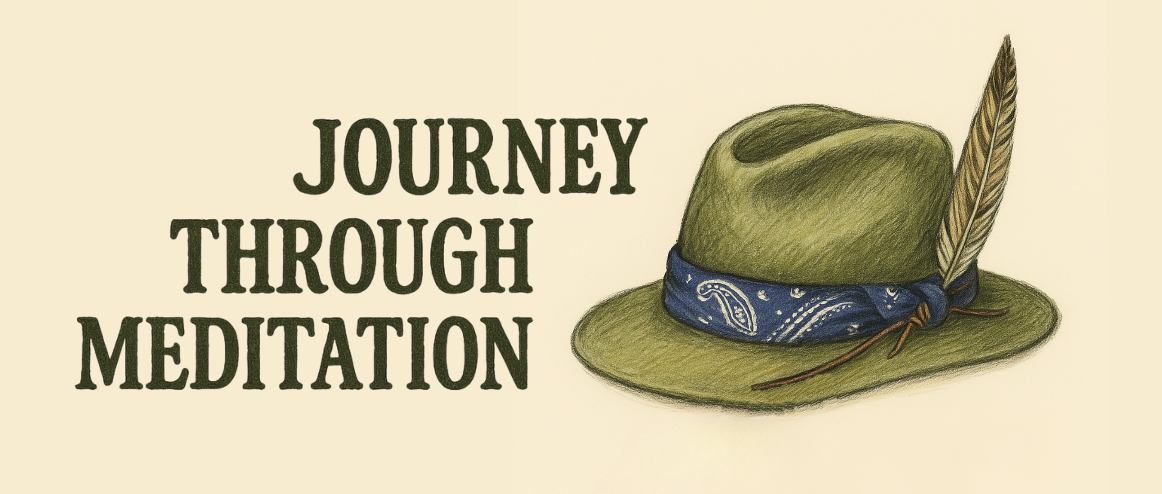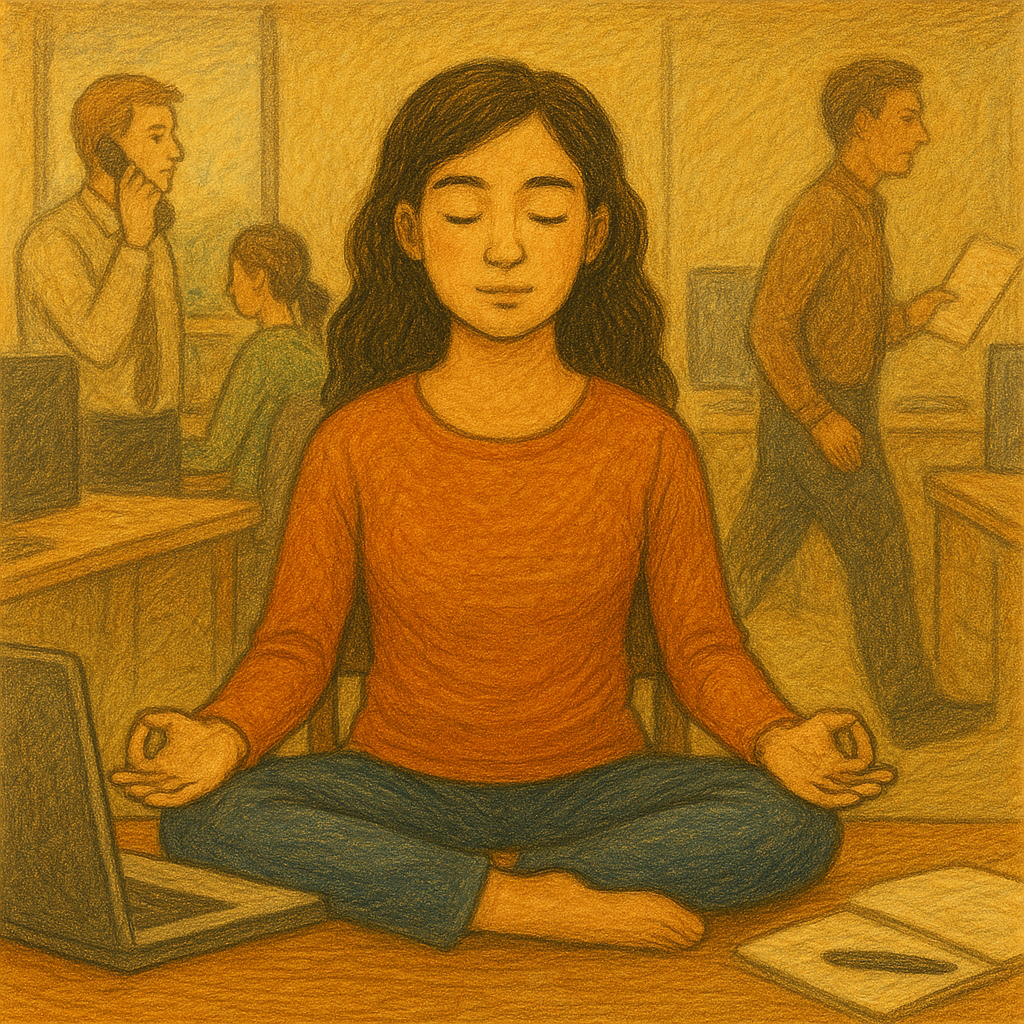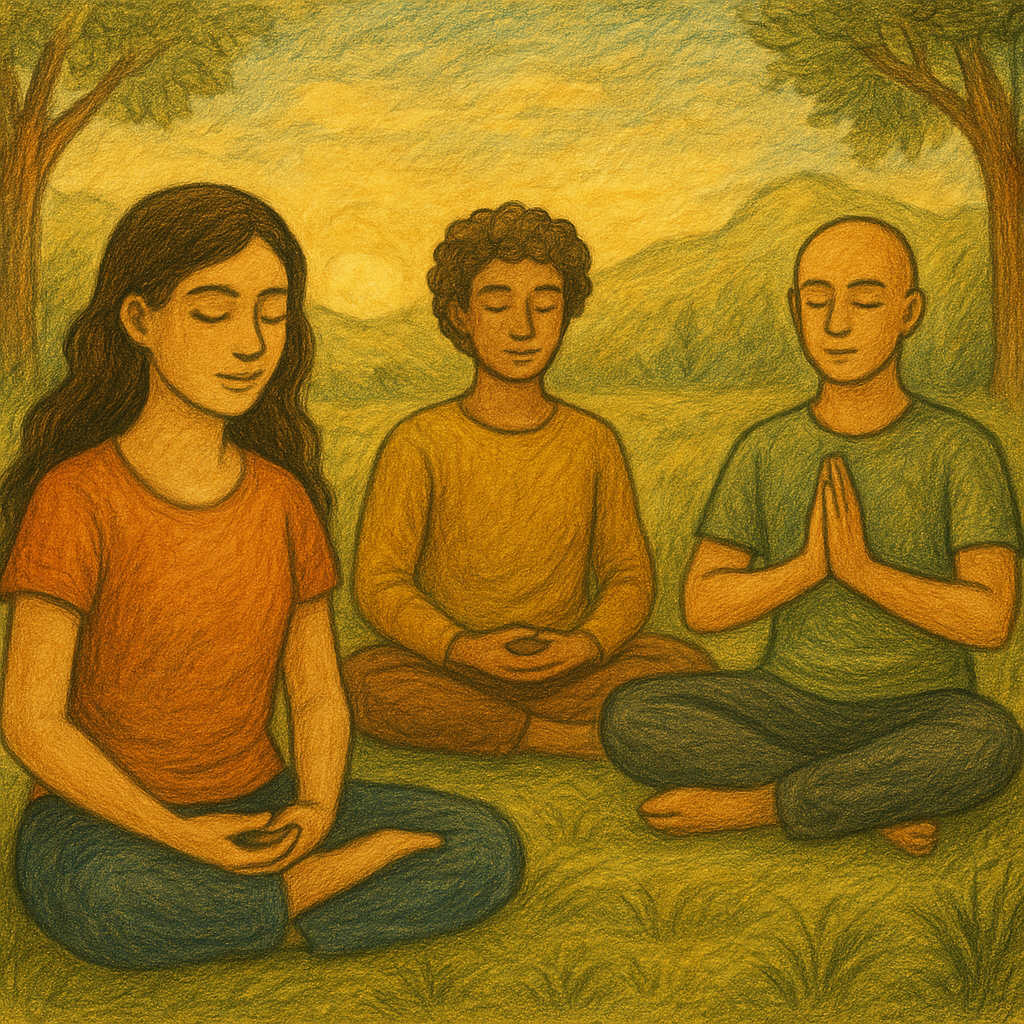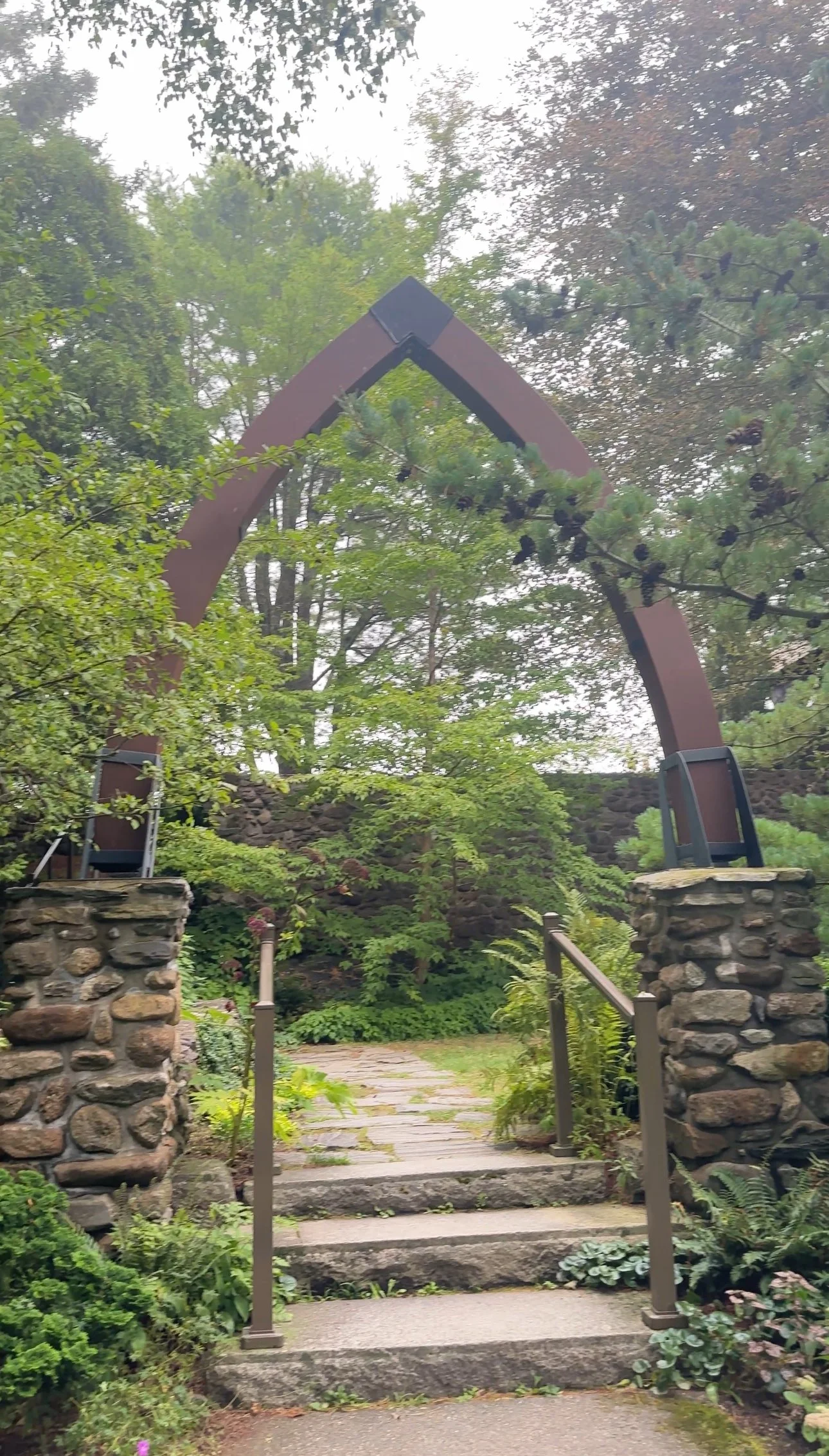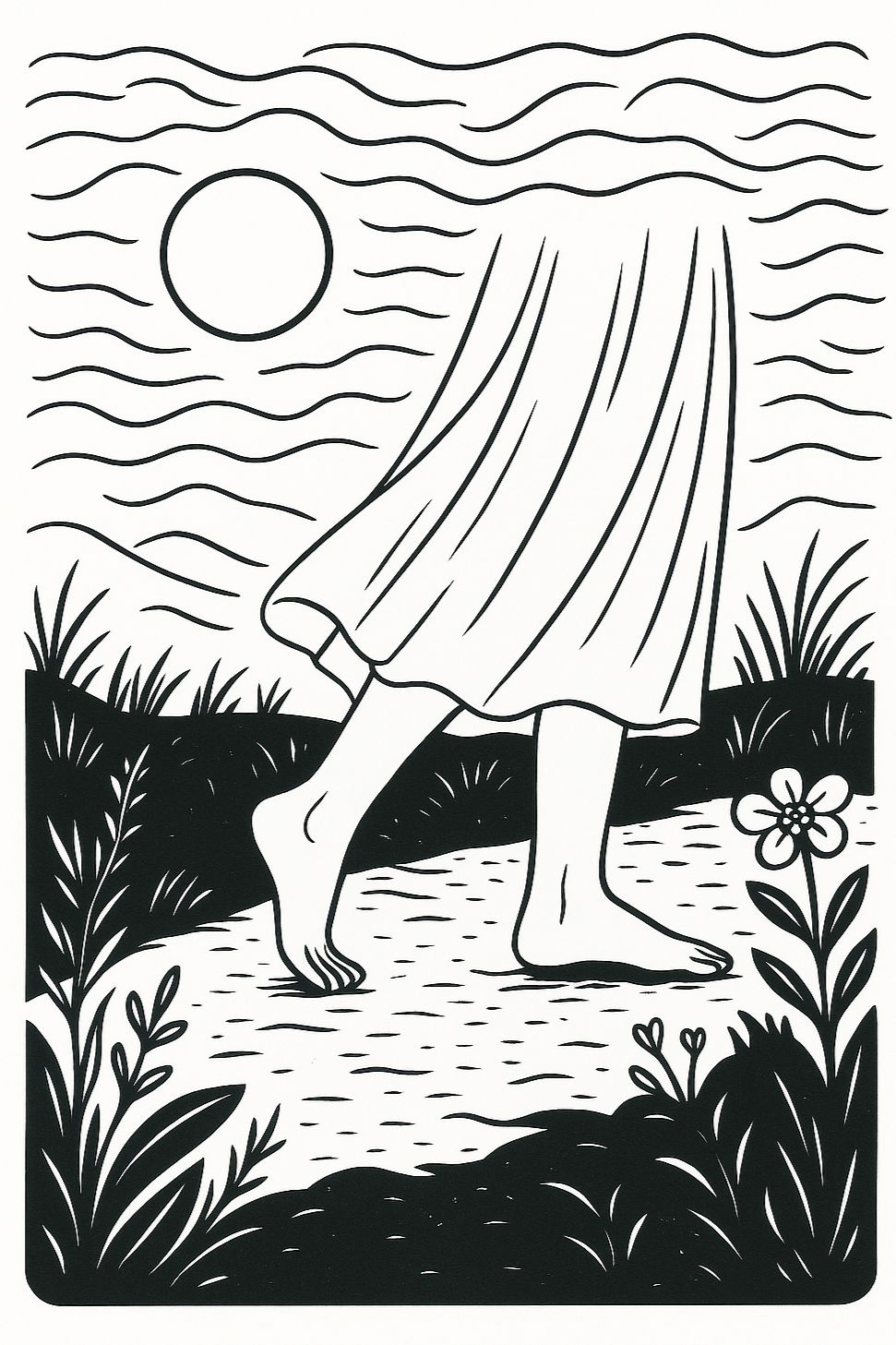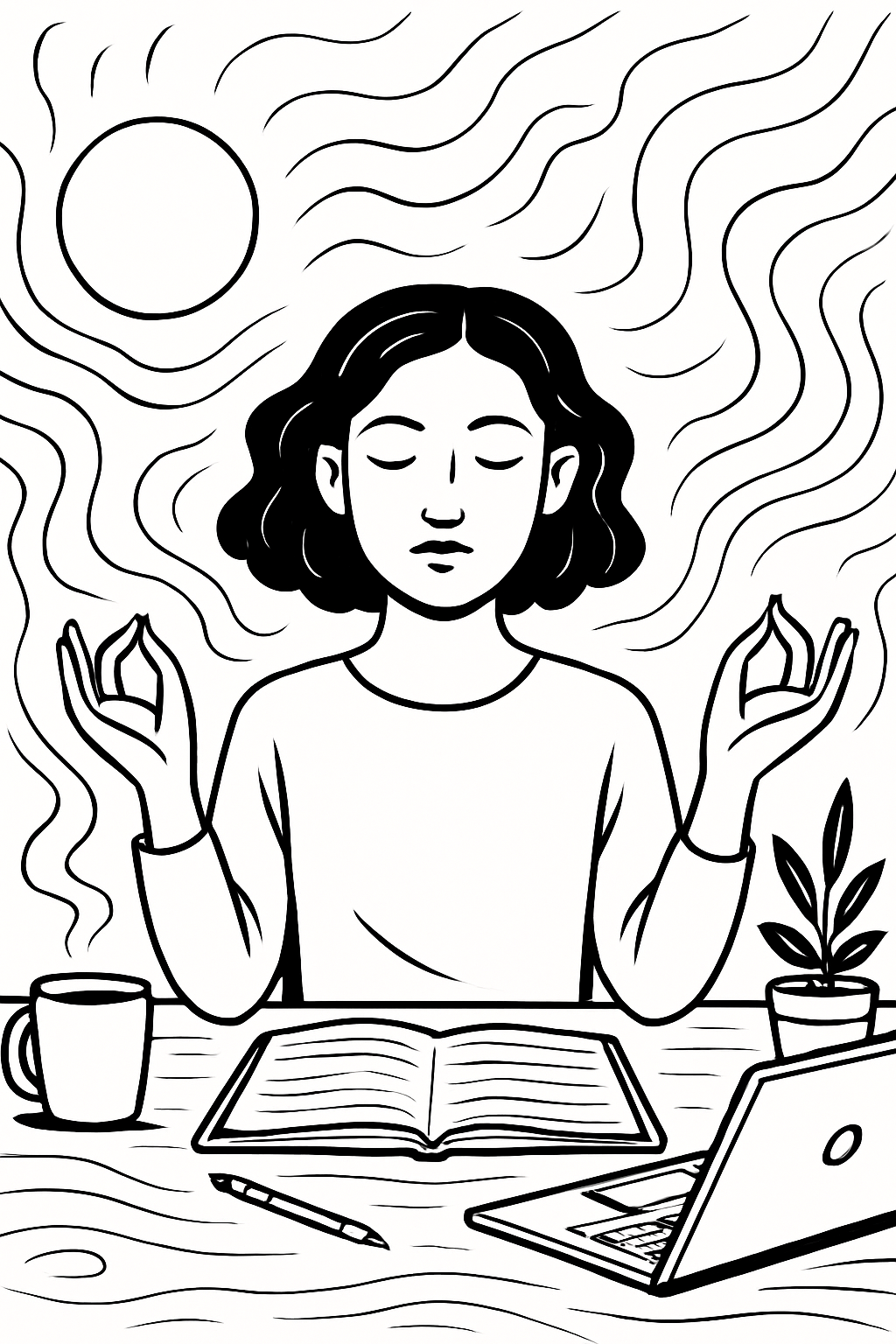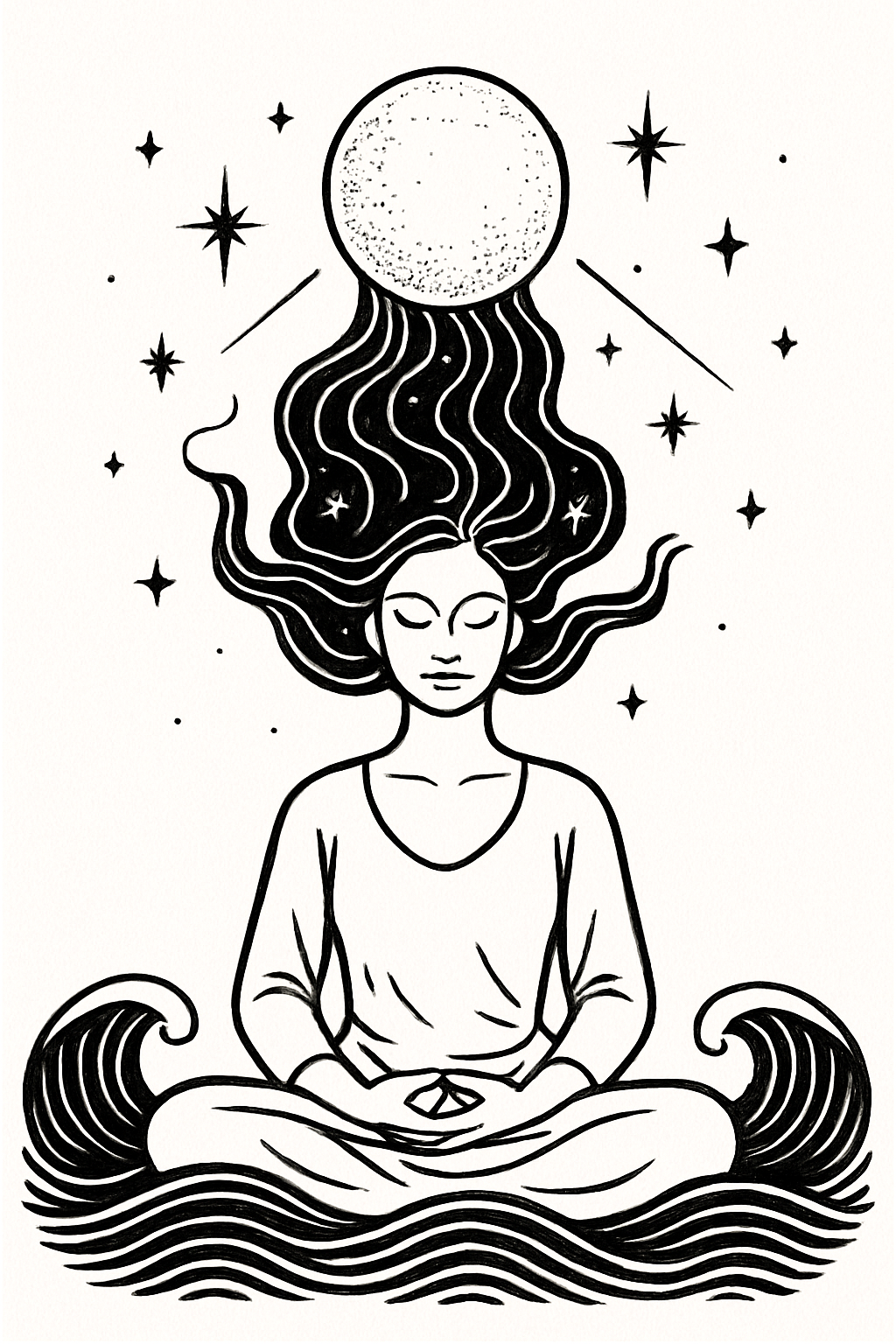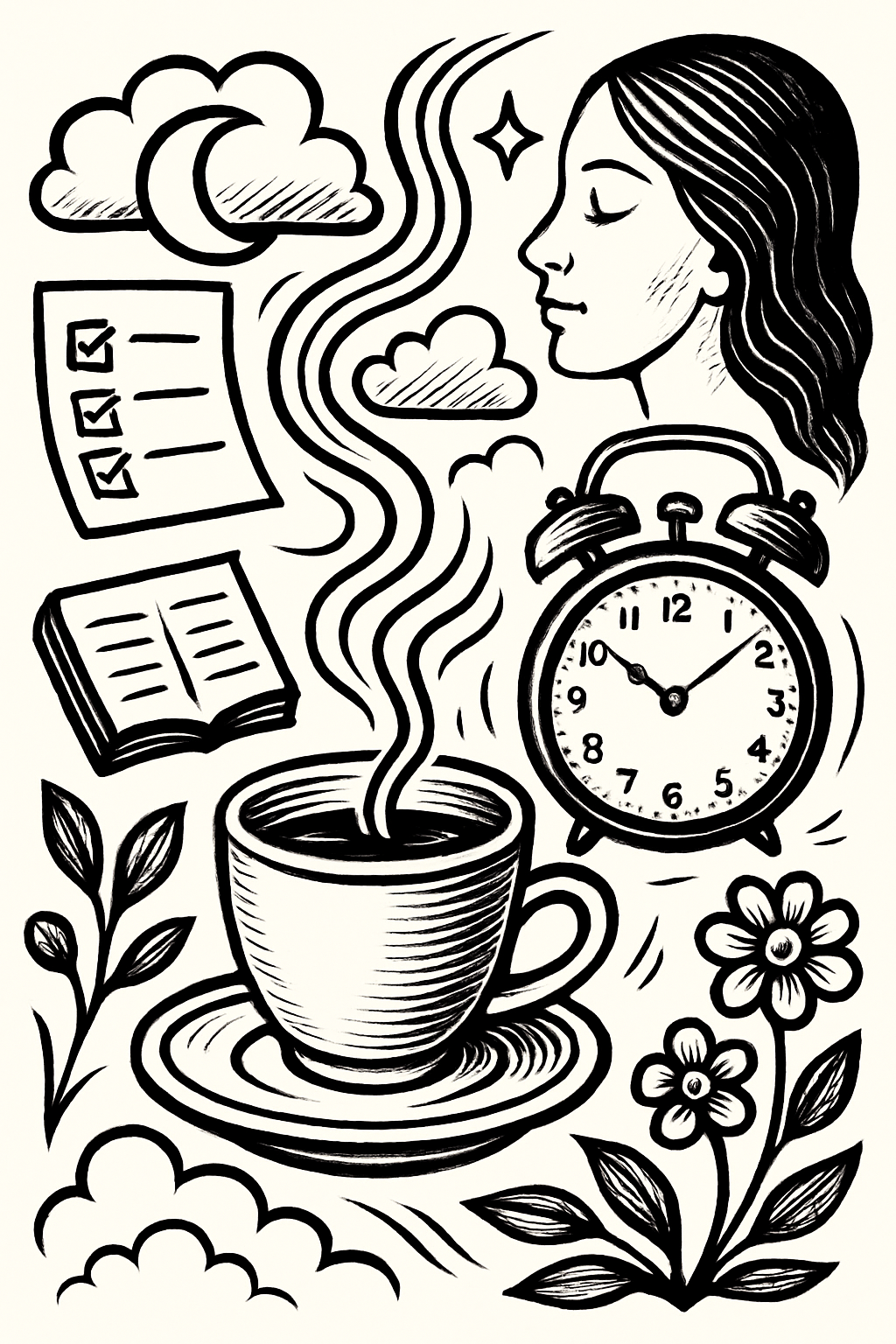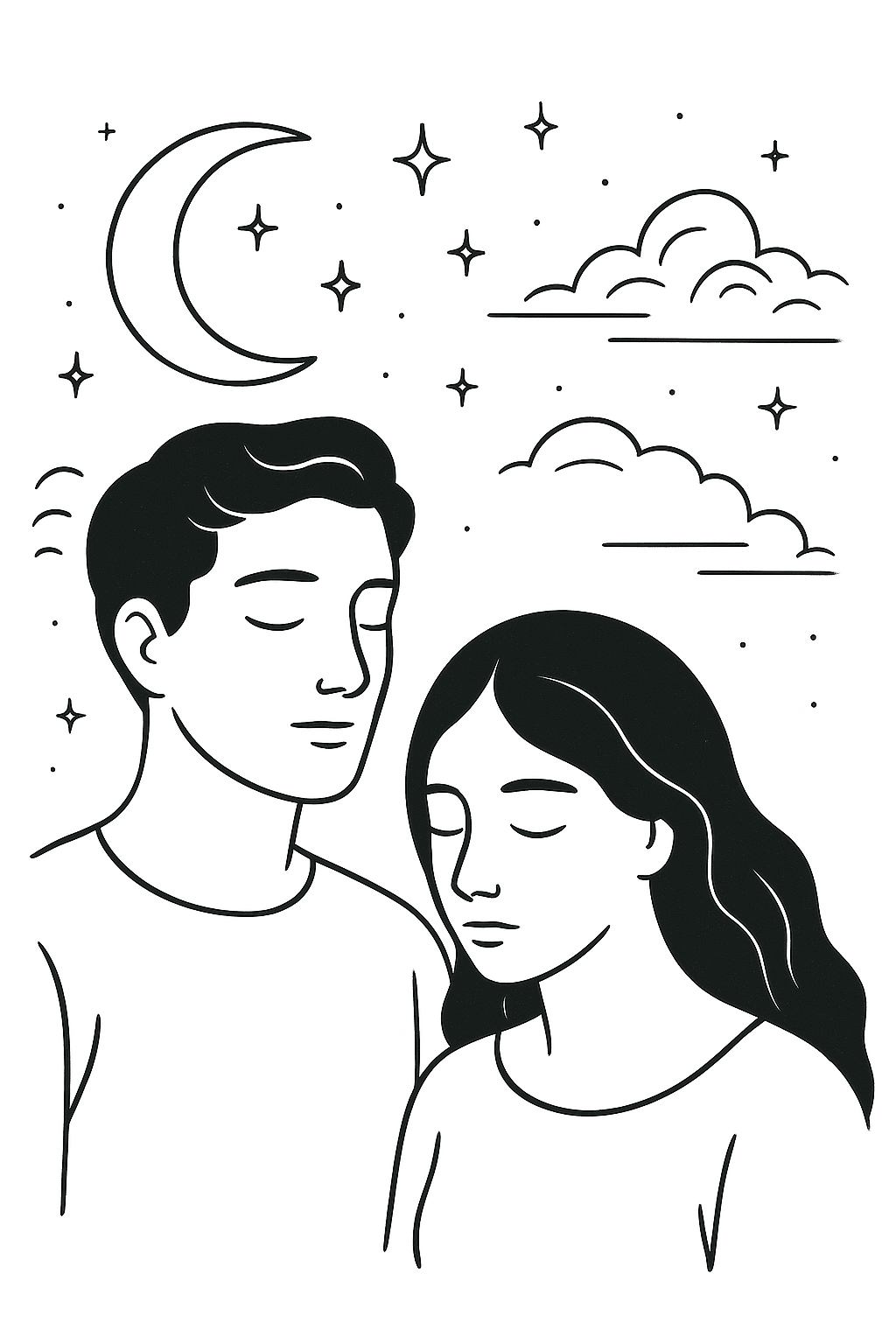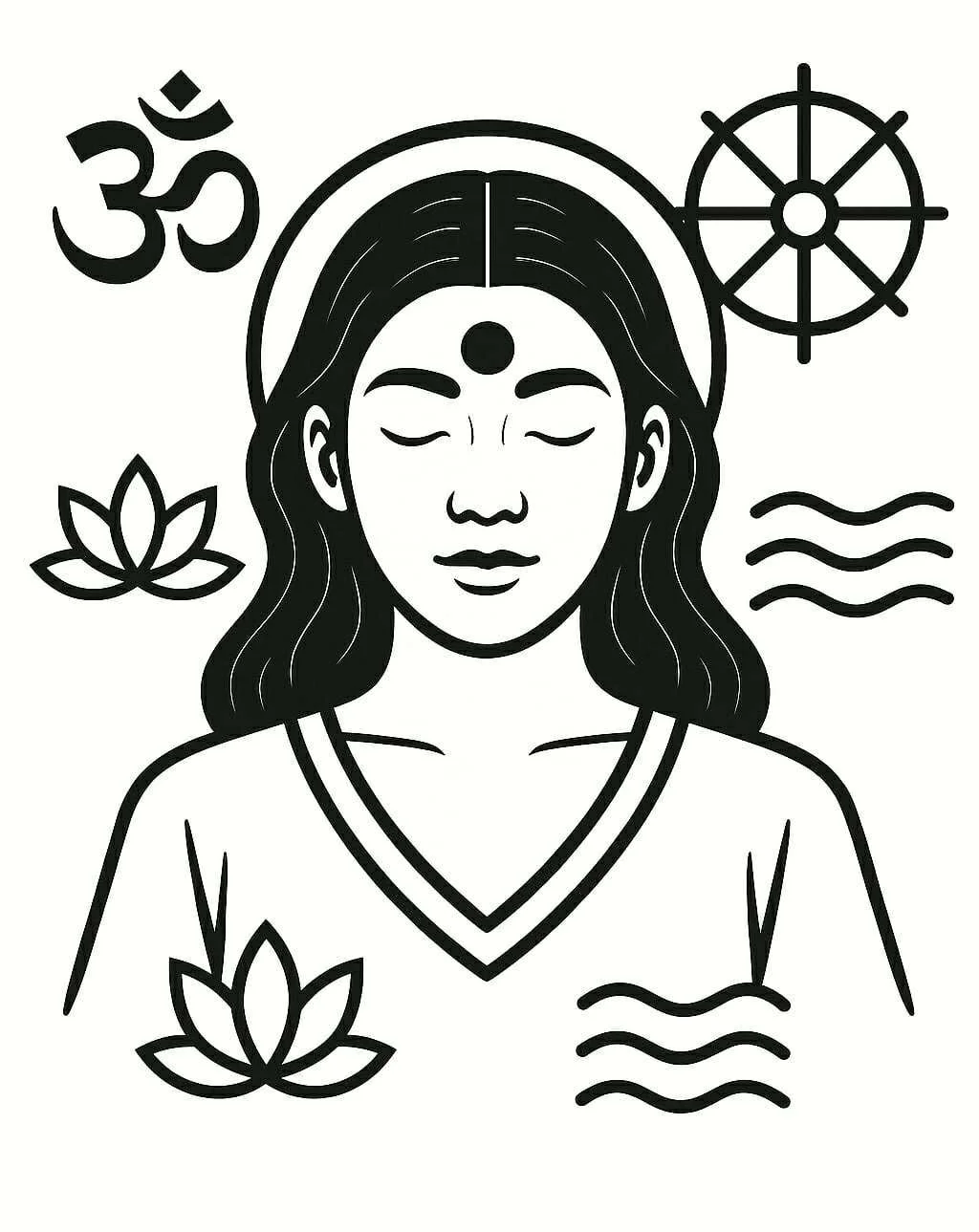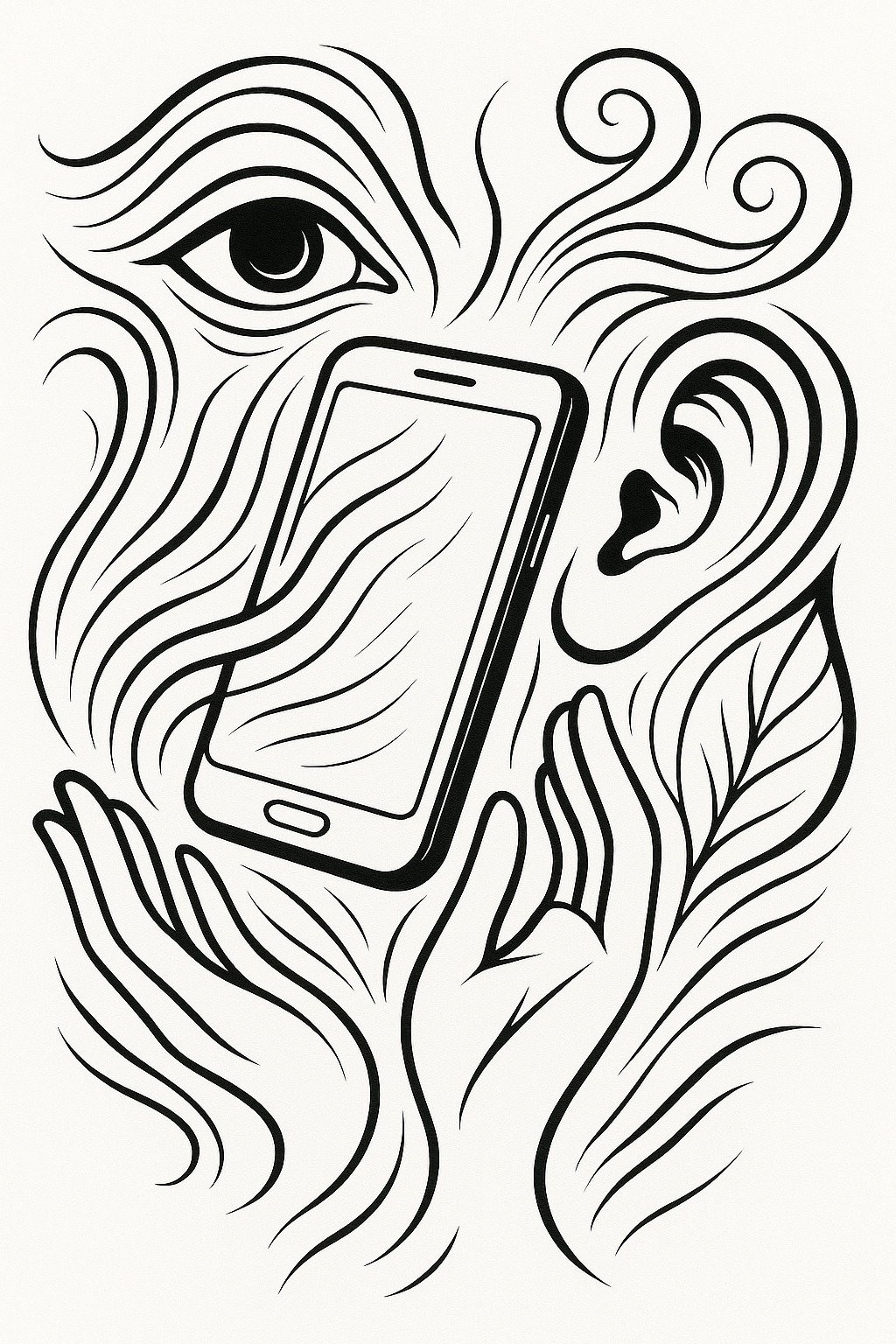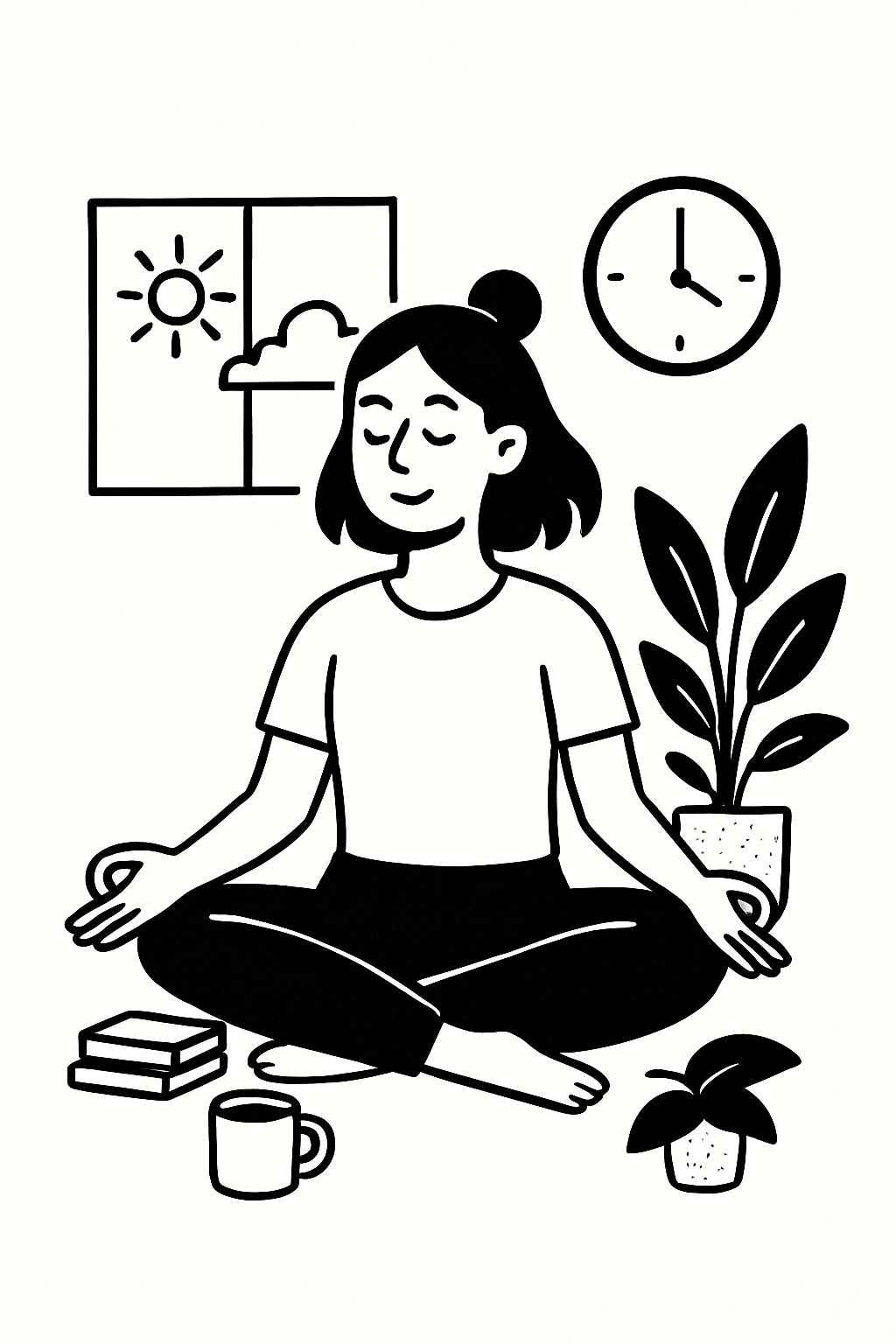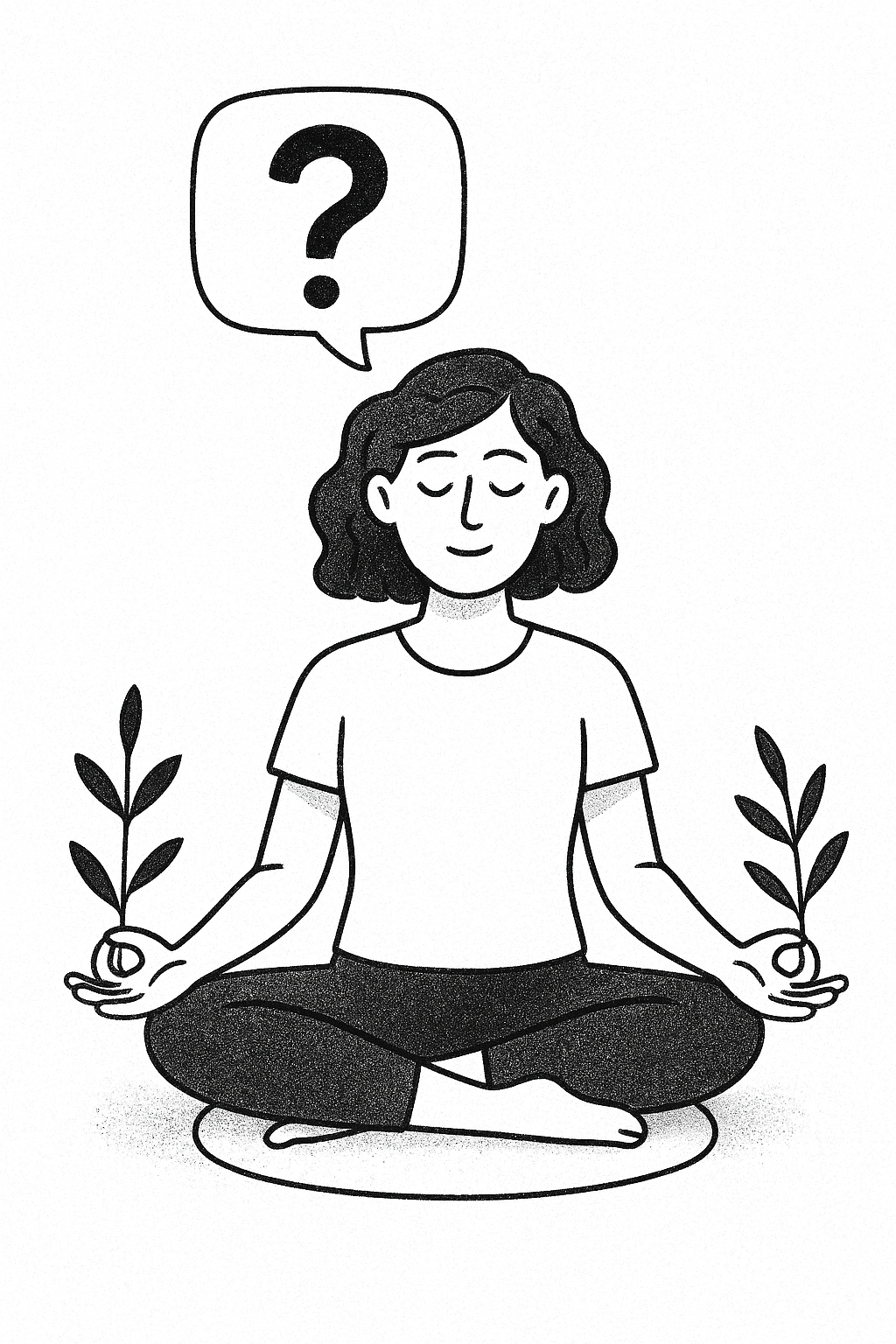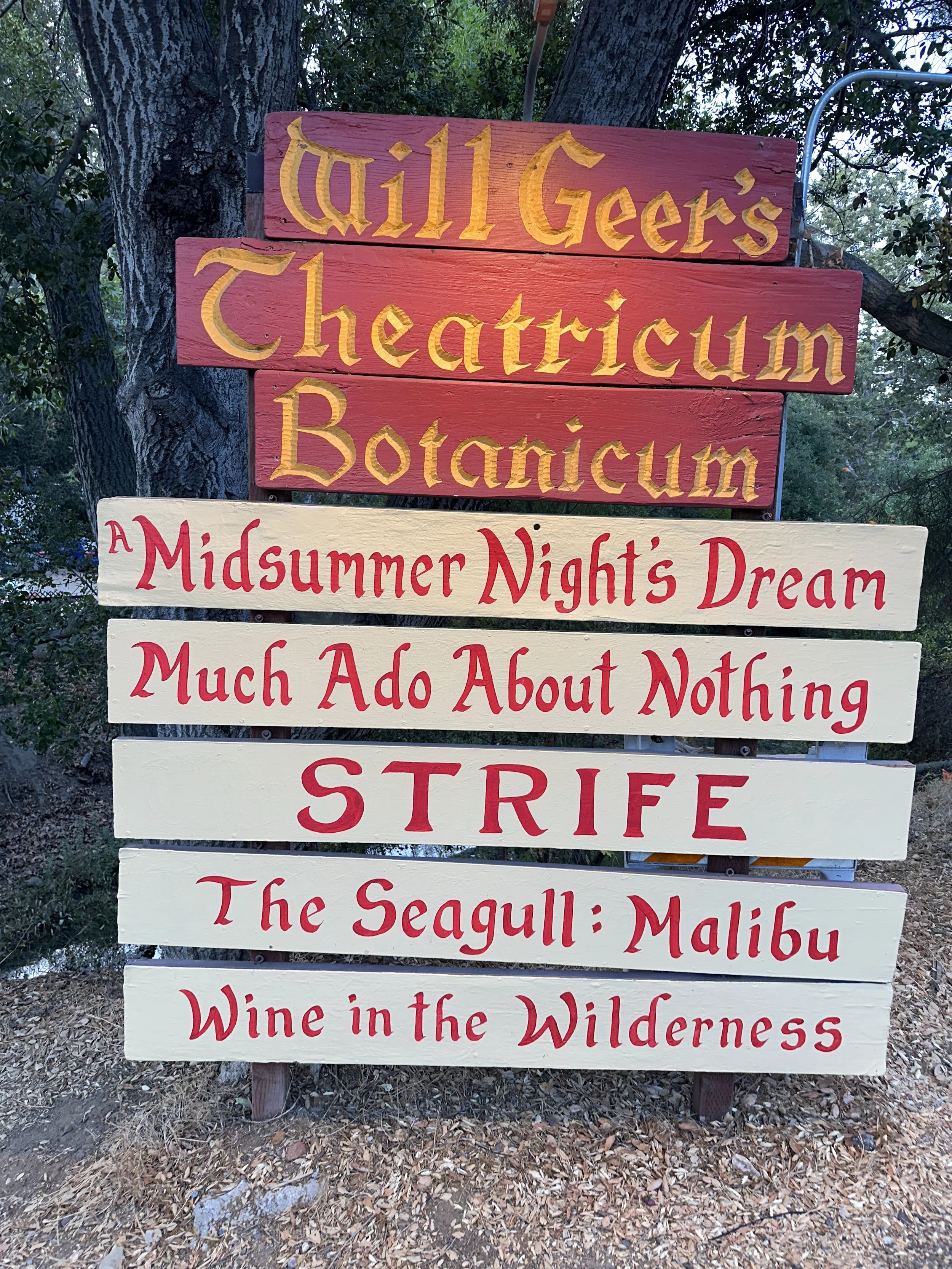Your Custom Text Here
Too Busy to Meditate? Here’s How 10 Minutes Can Change Your Entire Day
Think you’re too busy to meditate? Just 10 minutes a day can reset your mind, reduce stress, and improve focus. Learn how small, mindful breaks can make a big difference in your daily routine.
Life often feels like a nonstop sprint. The to-do list grows longer by the hour, phones keep buzzing, and “me time” usually means collapsing into bed at night. Meditation? For many, it sounds like a luxury reserved for people with empty calendars and Zen garden backyards.
But here’s the twist: meditation doesn’t have to take an hour, involve sitting cross-legged on a cushion, or require chanting under a Bodhi tree. In fact, carving out just 10 minutes can reshape the rhythm of your day—and the best part is, it fits neatly into even the busiest schedules.
So before brushing meditation aside with a “no time for that,” let’s break down how a small daily practice can actually make time feel like it’s on your side.
The Myth of “Not Enough Time”
The phrase “too busy to meditate” is a modern mantra. But think about this: how many minutes each day slip away scrolling through emails that don’t matter, checking news headlines you already know, or falling into social media rabbit holes? Those minutes add up.
Ten minutes—the length of a coffee break, half an episode of a sitcom, or two traffic light cycles when the universe isn’t cooperating—is all it takes. And unlike caffeine or doom-scrolling, meditation actually pays those minutes back in energy, clarity, and calm.
Why Ten Minutes Works
Sure, longer sessions bring deeper benefits. But research shows even short bursts of meditation can lower stress, sharpen focus, and improve mood. Ten minutes is enough to:
Hit reset on stress: Breathing deeply slows down cortisol spikes.
Boost focus: A calm mind makes it easier to cut through distractions.
Elevate mood: Mindfulness nudges the brain toward positivity instead of autopilot negativity.
Increase energy: Resting the mind, even briefly, recharges like a power nap without the grogginess.
Think of it like brushing your teeth. Two minutes of care each day keeps things from decaying. Meditation does the same for your mental hygiene.
Finding Ten Minutes (Yes, You Have Them)
The trick is not finding ten spare minutes—it’s choosing them. Here are a few realistic spots to steal from your schedule:
Right after waking up: Before checking notifications, sit in stillness. It sets a tone instead of reacting to one.
During lunch break: Step away from screens, breathe, and reset instead of eating while scrolling.
Between meetings: A short meditation acts like a palate cleanser for the mind.
Before bed: Wind down without the blue glow of a phone, easing into deeper rest.
It’s not about squeezing meditation into your day—it’s about swapping it in for something less helpful.
Quick Meditation Practices You Can Try Anywhere
Meditation doesn’t have to look mystical or dramatic. Here are a few simple methods to try, even if the only quiet place you find is the office restroom or parked car:
1. Box Breathing (4-4-4-4)
Breathe in for four counts, hold for four, out for four, hold for four. Repeat for ten rounds. It’s like hitting “refresh” on your brain.
2. Body Scan
Start at the top of your head and mentally scan downward. Notice tension in the jaw, shoulders, chest, belly, legs. No fixing—just noticing. Stress often dissolves on its own when acknowledged.
3. Noting Thoughts
When thoughts intrude (because they will), silently label them: “planning,” “worrying,” “remembering.” Then return to the breath. It’s not about emptying the mind—it’s about noticing what fills it.
4. Gratitude Pause
Think of three things—small or big—you’re grateful for in this moment. Gratitude pulls the brain out of scarcity and back into sufficiency.
How Ten Minutes Changes the Day
The beauty of short, consistent meditation is the ripple effect. Ten minutes in the morning can prevent a snappy email reply. Ten minutes at lunch can stop stress-eating chips at the desk. Ten minutes before bed can replace lying awake with racing thoughts.
The shifts aren’t always dramatic fireworks—they’re more like gentle course corrections that keep you moving toward calm instead of chaos.
Here’s what people often notice after making meditation a daily, bite-sized habit:
Conversations feel lighter. Less reactivity means fewer regrets.
Decisions come faster. A quieter mind cuts through noise.
The body feels better. Lower stress hormones can mean fewer headaches, stomach knots, or tension aches.
Time feels slower. Instead of racing, moments feel more present and manageable.
Ironically, the practice you thought you didn’t have time for makes the rest of your time feel more spacious.
Busting the Excuses
Still tempted to dodge meditation with excuses? Let’s clear them up.
“My mind won’t stop racing.” Perfect. That means you’re human. Meditation isn’t about stopping thoughts—it’s about noticing them without being hijacked.
“I don’t have a quiet space.” Earbuds + white noise = instant bubble of calm. A corner, a parked car, even the shower works.
“I’m not spiritual.” Great news: meditation isn’t reserved for monks or mystics. It’s a brain workout, not a belief system.
“I’ll start when life slows down.” Spoiler: life won’t slow down. But you can. Ten minutes is your pause button.
Making It Stick
Consistency beats intensity. Try these tips for weaving meditation into daily life:
Tie it to an existing habit. Meditate right after brushing teeth, or after pouring morning coffee.
Use a timer or app. That way you’re not peeking at the clock every 30 seconds.
Keep expectations light. Some days feel blissful, others feel distracted. Both are progress.
Celebrate the small win. Even one minute counts more than zero.
The goal isn’t perfection—it’s presence.
Your Ten-Minute Challenge
Here’s a simple challenge: for the next seven days, give yourself ten minutes. Pick a time, pick a practice, and stick with it. Notice how your days feel—less frazzled, more focused, a little more grounded.
Meditation isn’t about escaping life—it’s about being more alive in it. Those ten minutes you thought you didn’t have? They may just be the ten minutes that change everything.
Ready to Begin Your Journey?
If you’re curious about diving deeper into how meditation can fit into real life, check out The Journey Through Meditation ebook. Grab your free chapter here.
Sit, Stand, or Lie Down? Choosing the Best Pose for Your Meditation Practice
Finding the right meditation pose can transform your practice. Whether you sit, stand, or lie down, each position carries unique benefits for focus and relaxation. Explore which posture fits your lifestyle and deepens your mindfulness journey.
When people imagine meditation, the picture is often the same: someone sitting cross-legged on the floor, perfectly still, radiating calm. But here’s the truth — meditation isn’t about twisting into lotus or forcing your body into discomfort. The real secret is simple: the best meditation posture is the one that helps you stay present, comfortable, and awake.
So, should you sit, stand, or lie down when meditating? The answer depends on your body, your energy, and even the time of day. Each posture has its own benefits, and understanding them can transform your meditation practice from a daily struggle into something you actually look forward to.
Why Meditation Posture Matters
Your posture sets the tone for your meditation session. It influences your breathing, your alertness, and even how long you can comfortably stay still. Sit too rigidly, and you’ll spend the whole session battling aches. Lie down when you’re exhausted, and you may drift into sleep before your mind settles.
That’s why knowing the benefits of different meditation positions helps you choose what works for your lifestyle — and prevents frustration.
Sitting Meditation: The Classic Pose
Sitting is the most common meditation position — and for good reason. It creates balance: the body is stable, the mind stays alert, and the spine stays aligned so breath flows naturally.
But sitting doesn’t have to mean the full lotus position. Chairs, meditation benches, or even a pillow on the floor all count. What matters most is keeping the back straight but relaxed, shoulders soft, and hands resting naturally.
Benefits of Sitting Meditation:
Supports focus and concentration.
Encourages a sense of ritual and stability.
Keeps you alert and less likely to doze off.
Think of sitting meditation as your reliable morning coffee: steady, grounding, and easy to return to daily.
Standing Meditation: Energy on Your Feet
Standing meditation may not get as much attention, but it’s a powerful alternative. With roots in practices like Qigong and Zen, this posture wakes up both body and mind.
To try it, place your feet shoulder-width apart, keep knees slightly bent, and relax your arms. Imagine standing like a tree: rooted, steady, but alive with quiet energy.
Benefits of Standing Meditation:
Boosts alertness and body awareness.
Helps fight fatigue or restlessness.
Perfect for short, energizing sessions.
Standing meditation is like your afternoon energy drink. It won’t let you drift into drowsiness, and it’s great for sneaking mindfulness into daily life — while waiting for the kettle to boil or during work breaks.
Lying Down Meditation: Deep Rest and Release
Lying down may sound like cheating, but it’s actually a valid and deeply restorative meditation posture. Practices like yoga nidra use this position to guide the mind into profound relaxation while the body fully lets go.
Simply lie flat on a mat, bed, or floor. Let the arms rest by your sides, palms up. Close your eyes, breathe naturally, and allow gravity to take over.
Benefits of Lying Down Meditation:
Fully relaxes the body.
Reduces stress and promotes deep rest.
Accessible for anyone with pain, fatigue, or mobility issues.
This posture is your cozy hot chocolate after a long day — soothing, comforting, and just what the body sometimes needs. The challenge is staying awake, but that’s part of learning awareness.
How to Choose the Best Meditation Posture
There’s no single “best meditation position” that works for everyone. The right posture depends on your goals and energy. Here’s a quick guide:
For focus and consistency: Sit tall and centered.
For energy and wakefulness: Stand strong like a rooted tree.
For relaxation and recovery: Lie down and let go.
The trick is flexibility. Meditation postures are tools, not rules. By switching based on your needs, you’ll make meditation more sustainable.
When to Use Each Posture During the Day
Optimizing posture by time of day can make meditation even more effective:
Morning meditation: Sitting helps set focus for the day without drifting back to sleep.
Midday meditation: Standing refreshes energy and cuts through brain fog.
Evening meditation: Lying down helps release stress and prepare for restful sleep.
This way, your posture matches your natural energy flow — and you’ll get more from your practice.
Quick Tips for Comfortable Meditation Positions
No matter which posture you choose, these tips will keep your practice enjoyable and pain-free:
Use props: Cushions, pillows, or yoga blocks make sitting more sustainable.
Check alignment: Straighten the spine gently, but don’t lock the body into stiffness.
Stay mindful of comfort: Adjust if you feel sharp pain or numbness — discomfort isn’t a badge of honor.
Experiment: Try different postures until you find what supports your body best.
Beyond the Posture: What Really Matters
Meditation positions are important, but they aren’t the main event. Sitting, standing, or lying down simply creates the stage. The real focus is your awareness — the ability to notice your thoughts, emotions, and breath without judgment.
So don’t stress about “getting it right.” The best meditation posture is the one that allows you to keep showing up.
The Takeaway
Meditation isn’t about looking like a monk on a mountaintop. It’s about creating space for awareness in the middle of everyday life. Some days you’ll sit like a steady cup of coffee, other days you’ll stand like an energy drink, and sometimes you’ll lie down like a warm blanket.
The pose doesn’t define the practice — your awareness does. Experiment, adapt, and let your body guide the way.
Want to explore meditation postures and practices that truly fit your lifestyle? Check out The Journey Through Meditation ebook. Grab your free chapter here.
The Beauty of a Wedding in Nature
Weddings are more than rituals of love — they are moments of presence, union, and awakening. Outdoors, surrounded by trees, ocean, or sky, a wedding becomes not just a ceremony but a meditation, drawing us into connection with each other and the living world.
Weddings are an opportunity to open the heart. They bring people together in love, convene community in shared presence, and often weave together different heritages into one celebration.
Much like meditation, weddings share the ultimate goal of union. Union with another is the external enactment of the same ultimate union we discover inwardly — the union with God.
A wedding is also an invitation to mindfulness. Each moment is fleeting — the walk down the aisle, the exchange of vows, the sound of music carried on the breeze. These moments can never be repeated in quite the same way, which is what makes them so precious.
Weddings open our hearts not only through the joining of two people, but through the presence of family and friends from across the many chapters of life. They move us, soften us, and sometimes bring us to tears.
Why Outdoor Weddings Are So Powerful
Outdoor weddings deepen the experience because they increase our connection to each other by reconnecting us with nature. They remind us that we are not separate from the living world, but held within it.
An outdoor ceremony is special because it exists in a unique moment in time, away from the distractions of urban life — no traffic, no technology, only the immediacy of the land and sky.
The sound of birdsong. The feeling of wind across the skin. The roots beneath your feet as you walk along the path. The smell of pine or salt in the air. Each sensory detail becomes part of the ceremony, reminding us that love is always nourished by the earth itself.
Some beautiful reasons to choose an outdoor wedding:
To be surrounded by living beauty — trees, flowers, water, sky.
To let the natural world become your décor, effortless and timeless.
To give guests the gift of presence, inviting them to pause and breathe with the land.
To root your vows in the same ground that holds and sustains life.
Weddings in the Rain or Fog
Of course, outdoor weddings also bring unpredictability. The weather may turn. Rain may fall. Fog may roll in. But rather than obstacles, these elements can become blessings in disguise.
To stand outside a wooded chapel holding an umbrella, to feel the mist touch your skin, or to see the world softened by fog — these are reminders that love endures in all conditions.
Rain speaks of renewal and new beginnings. Fog draws people closer in intimacy.
Even the challenge of nature becomes part of the story, shaping the memory in ways no indoor setting could ever replicate.
Weddings in the Woods
There is something magical about exchanging vows in a forest. The trees form a living cathedral, their trunks like pillars, their canopy like a vaulted ceiling. The air is rich with the scent of earth and pine. Roots ground the couple in stability while leaves whisper blessings overhead. A woodland wedding reminds us of love’s resilience and rootedness.
Weddings by the Ocean
By the ocean, love takes on the language of vastness. The salt air refreshes and awakens the senses, while the waves speak of rhythm and eternity. To stand at the edge of the sea is to stand at the threshold of the infinite. The ocean itself, deep and boundless, becomes a mirror for love’s own depth. An ocean wedding carries the symbolism of openness, renewal, and infinite possibility.
Making Weddings More Mindful
Whether indoors or out, every wedding can be deepened with mindfulness. Simple practices can transform a ceremony into a meditation:
Begin with a shared silence, inviting everyone to take a breath together.
Choose rituals that honor both the couple and the land — such as ringing a bell, planting a tree, or walking barefoot.
Invite guests to notice their senses: the sound of the wind, the scent in the air, the way light moves through the space.
Incorporate music that feels like an extension of the natural surroundings.
When we bring mindfulness into a wedding, it becomes more than a ritual — it becomes a spiritual awakening. It is a reminder that love, presence, and nature are all threads of the same tapestry. And when woven together, they create moments that linger long after the day has passed.
For more ways to bring presence into daily life, explore The Journey Through Meditation ebook — your guide to simple, nature-inspired mindfulness. Grab your copy here.
A Wedding in the Fog
This past weekend I traveled to Camden, Maine, for my sister’s wedding. Held in a small wooded outdoor chapel overlooking Casco Bay, the ceremony unfolded in fog and birdsong, surrounded by family and friends. It was a tender reminder that love, like meditation, invites us into presence — fleeting, precious, and unforgettable.
This past weekend, I traveled from Los Angeles to Camden, Maine, for my sister’s wedding. The ceremony was held in a wooded outdoor chapel overlooking Casco Bay. It felt like a little church of nature — trees all around, ocean in view, and no sound of cars or traffic, only birdsong and breeze.
A tender gathering
It was a foggy day, umbrellas ready in case of rain. The benches inside the pergola were too few, so guests stood around the outside, looking in. Live music played softly at the side as my sister, holding my father’s hand, came up the wooded entrance and around the corner. Watching her walk forward, I nearly cried.
I sat in the front row with my parents and youngest sister, the camcorder in my hand. I delivered the rings during the ceremony — a simple but meaningful role. From that seat, I could look back and see family and friends gathered from different chapters of life, each one there to offer love and recognition.
Two cultures, one union
My sister Lindsey and her partner Joaquin brought together two cultures — American and Mexican. A lasso was placed around them, symbolizing their union. When the vows were complete, my youngest sister rang the bell, and with its sound the ceremony came to a close. Everyone stepped down from the little outdoor chapel smiling, carried by the joy of the moment.
The presence of love
Weddings are unique because they gather us in presence — not just for the couple, but for everyone who witnesses. In that foggy clearing, we were reminded of what it means to pause, to honor, and to celebrate love in its purest form.
Moments like this are fleeting; they can never be repeated in the same way. But when we are attentive, they live on in us — a reminder that life’s truest ceremonies often happen not in grand cathedrals, but in quiet places where nature, family, and spirit meet.
The Earth Beneath: How Walking Barefoot Becomes a Transcendental Practice
Walking barefoot may seem simple, but it holds powerful benefits for clarity, grounding, and stress relief. When paired with transcendental meditation, it becomes a transcendental practice that aligns body, mind, and nature. Learn how this ancient habit can reset modern life.
The Grounding Power Beneath Every Step
Shoes often act as a barrier between humans and the natural world. Every layer of rubber and fabric creates distance from the ground that supports life itself. Walking barefoot, often called “earthing” or “grounding,” is more than just a quirky wellness trend. It is a deeply human practice that reconnects the body and mind to the rhythms of nature in the simplest way possible—by stepping directly onto the earth.
It might sound ordinary, but the act of touching soil, grass, or sand with bare feet can transform into a transcendental practice that awakens presence, clarity, and inner calm.
Why Barefoot Walking Feels Different
Think of the last time feet pressed against cool grass or warm sand. The sensation was probably so immediate and vivid that it pulled attention into the moment. This is mindfulness at its most tactile—no app, no special technique, just direct connection with the earth.
Science backs up what intuition already knows. Barefoot contact with natural surfaces is thought to help regulate the nervous system, reduce stress, and improve sleep. Beyond biology, though, is the mental shift: barefoot walking reminds the mind that life is not just schedules, screens, and deadlines—it is also texture, temperature, and sensation.
A Return to Something Ancient
For most of human history, walking barefoot was not a practice—it was a way of life. Feet adapted to soil, stones, and uneven ground, forming a natural relationship with the land. Today, reintroducing this contact feels like slipping back into an ancient rhythm.
Each step becomes a quiet meditation. The crunch of gravel, the softness of moss, or the firmness of earth underfoot turns into a reminder: the planet is not something separate. It is a living ground that carries, supports, and nourishes every being.
Turning Walking into Transcendence
Walking barefoot is not just about removing shoes; it’s about shifting awareness. A walk across a lawn or along a beach can be transformed into a mindful ritual with a few subtle changes:
Slow Down. Instead of rushing, let each step land with attention. Notice how the surface feels—cool, warm, soft, or rough.
Breathe with the Step. Syncing breath with movement deepens presence. Inhale with one step, exhale with the next.
Engage the Senses. Feel the ground, listen to the wind, notice the colors around. The experience widens from feet to full awareness.
Let the Mind Settle. If thoughts drift, let them pass like clouds and return to the next step underfoot.
Soon, walking ceases to be just movement. It becomes transcendence: a way of experiencing life with depth and stillness, grounded in something larger than the self.
Nature’s Quiet Therapy Session
Modern life constantly pulls upward—into the head, into screens, into planning and overthinking. Barefoot walking gently reverses the pull. It grounds energy downward, anchoring attention into the present.
Many who practice it describe a surprising sense of relief, as if the earth itself absorbs stress and restores balance. Even a short barefoot walk in a backyard, garden, or park can feel like a reset button for the mind.
The Subtle Magic of Everyday Grounding
Walking barefoot does not require exotic retreats or spiritual ceremonies. It can happen during an afternoon break, while tending to a garden, or on a morning stroll through dew-covered grass. These small, ordinary moments carry extraordinary potential.
The magic lies in the shift of awareness. By turning something as common as walking into a mindful ritual, the ordinary becomes a doorway into transcendence.
The Takeaway: Feet on the Ground, Mind in the Present
The practice of walking barefoot is not about rejecting shoes or chasing wellness trends. It is about rediscovering a forgotten intimacy with the ground beneath every step. It is about slowing down, noticing sensations, and allowing something simple to become something sacred.
The transcendence is not in the act itself—it is in the awareness it awakens. Each barefoot step is an invitation to return to presence, to quiet the mind, and to remember that clarity often begins from the ground up.
For more tools and inspiration, check out The Journey Through Meditation ebook. Grab your free chapter here.
Desk Meditation: Simple Practices to Beat Burnout
Burnout doesn’t always need a retreat or weekend getaway. Sometimes, the cure is just a breath away—right at your desk. With simple, desk-friendly meditation practices, stress softens, focus sharpens, and workdays feel lighter.
Burnout isn’t always loud. Sometimes it shows up quietly—like the unread emails piling up, the coffee that no longer wakes you, or the sigh that escapes every time the calendar notification dings. In today’s hustle culture, the desk itself has become a battlefield of stress. But what if the cure wasn’t found in a weekend getaway or a wellness retreat, but in the very place where burnout brews?
Desk-friendly meditation offers that reset button—simple, accessible, and surprisingly effective.
Why Burnout Sneaks In at the Desk
Desks are designed for productivity, not presence. The posture, the endless screen glare, and the constant pressure to “do more” trick the nervous system into living in fight-or-flight mode. Even if the body is sitting still, the mind is sprinting marathons.
That constant mental race is what fuels burnout. It’s not just about being busy; it’s about being always on. Without micro-moments of rest, the system eventually crashes.
Desk Meditation: The Reset You Didn’t Know You Needed
Meditation at the desk doesn’t require candles, silence, or even closing your eyes. It’s about stealing back tiny slices of calm in the middle of chaos. Think of it as hitting “refresh” on your brain while your laptop loads another spreadsheet.
The beauty of desk meditation? It doesn’t add one more thing to the to-do list—it transforms what’s already happening.
3 Simple Desk-Friendly Practices
1. The 60-Second Breath Reset
Close your email tab. Place both feet flat on the ground. Take a slow inhale for four counts, hold for two, and exhale for six. Do this three times. That’s one minute. Suddenly, the shoulders drop, the jaw unclenches, and the inbox feels less threatening.
2. The “Eye Stretch” Meditation
Screens strain not just the eyes, but the mind. Every 20 minutes, shift your gaze to something far away—a window, a plant, even the ceiling corner. Take three full breaths while focusing there. This simple shift calms overstimulation and gives the brain a chance to reset.
3. The Gratitude Sticky Note
Burnout thrives on feeling stuck in the grind. Combat it by jotting down one small thing you’re grateful for on a sticky note and placing it near your monitor. Every glance becomes a micro-meditation, a reminder that there’s more to life than deadlines.
Why It Works
The desk isn’t the enemy; distraction is. Burnout thrives in environments where stress builds unchecked. By inserting small, mindful pauses directly into the workspace, meditation interrupts the cycle.
These practices work because they shift the nervous system. The body moves from “fight-or-flight” to “rest-and-reset.” Even two minutes of mindful breathing signals safety to the brain, lowers cortisol, and boosts focus.
From Desk Job to Daily Reset
Think of these moments not as breaks, but as maintenance. Just like a computer slows down without updates, the mind loses clarity without pauses. Desk meditation isn’t about perfection—it’s about small resets that add up over time.
Burnout doesn’t vanish overnight, but these tiny tools chip away at the weight. Over days and weeks, the desk transforms from a burnout trap to a mindfulness ally.
Final Thought
The cure for burnout isn’t always found outside the office walls. Sometimes it’s waiting right at the desk—between keystrokes, inside a breath, or scribbled on a sticky note. The desk can either drain or restore, depending on how it’s used.
For more tools and inspiration, check out The Journey Through Meditation ebook. Grab your free chapter here.
Like the Moon and Tides: How Meditation Syncs You to Something Greater
Ever feel a pull toward something larger than yourself? Much like the moon governs the tides, meditation can sync your personal energy with the vast rhythms of the universe. This practice isn't just about finding calm; it's about discovering your connection to a greater cosmic dance.
Every night, the moon silently tugs at the ocean, pulling entire tides without making a sound. It doesn’t demand attention, yet its influence is undeniable. In many ways, meditation works the same way. It quietly reshapes inner rhythms, syncing the mind and body to something larger, steadier, and more meaningful than daily chaos.
This is not about becoming mystical or chasing the cosmic. It’s about noticing how stillness, much like the moon, can recalibrate life in powerful, almost invisible ways.
The Rhythms That Run Life
Daily life runs on rhythms—emails, alarms, traffic lights, endless notifications. These rhythms are loud, demanding, and often stressful. But beneath them, quieter cycles exist: the rise and fall of the breath, the body’s natural energy flow, even the shifting moods of the mind.
Meditation works by tuning into these subtler rhythms. Instead of fighting against them, it creates space to ride them—like the tide flowing with the moon’s pull.
Why Stillness Feels So Restorative
Ever noticed how stepping away from noise, even for just a few minutes, feels like a reset button? Meditation magnifies that effect. By slowing the breath and focusing attention, the nervous system signals the body to relax. Heart rate steadies. Muscles soften. Thoughts quiet down.
It’s not about forcing calm; it’s about syncing to the natural balance already present. Just as the tides don’t strain to follow the moon, the body doesn’t need to strain to find alignment. It only needs permission.
The Everyday Science of Syncing
This isn’t just poetic—it’s physiological. Studies show that meditation helps regulate brainwave activity, lowering stress hormones and improving emotional regulation. That’s a scientific way of saying: the more regularly meditation happens, the easier it becomes to flow with life instead of against it.
Think of it like tuning a guitar. When one string is off, the whole instrument sounds wrong. Meditation tunes the “strings” of attention, energy, and focus, helping life feel more harmonious.
How to Catch the “Tide” of Meditation
Meditation doesn’t need to be complicated. Syncing with something greater starts with the simplest habits:
Morning reset: Take 5 minutes before opening the phone to sit in silence and notice the breath.
Midday pause: Between meetings or errands, close the eyes for three deep breaths. Imagine exhaling stress like waves leaving the shore.
Evening release: Before bed, trade scrolling for stillness. Let the day “ebb away” the way tides recede at night.
Consistency matters more than length. The more often these pauses happen, the more natural the rhythm becomes—like catching the tide at the right time.
When Life Feels Out of Sync
Everyone has days when nothing flows. Traffic jams. Missed deadlines. Conversations that drain instead of energize. Meditation doesn’t erase these moments, but it changes the relationship with them.
Instead of fighting the current, meditation teaches how to float with it. The frustration is still there, but it no longer defines the day. This shift—subtle but profound—is where the deeper connection begins.
A Quiet Connection to Something Greater
So what exactly is this “something greater”? For some, it feels spiritual. For others, it’s a stronger connection to nature, community, or simply a clearer version of themselves. The beauty is, it doesn’t need to be labeled.
Like the moon, meditation influences without needing explanation. It reminds that life is not just deadlines and noise, but also cycles, flow, and connection to rhythms far beyond a single to-do list.
Final Thought
Meditation doesn’t demand hours of silence or perfect focus. It asks only for presence—small moments of attention that, like the moon on the tide, ripple outward in ways that can’t always be seen but are always felt.
The next time stress feels like an incoming wave, pause. Breathe. Sync. There’s a greater rhythm waiting to carry you.
For more tools and inspiration, check out The Journey Through Meditation ebook. Grab your free chapter here.
From To-Do Lists to Tea Cups: Turning Daily Habits into Mindful Moments
The day can feel like a blur of to-do lists, chores, and deadlines — but mindfulness offers another way. By turning everyday habits into anchors of presence, even the simplest rituals become opportunities for calm. From savoring a cup of tea to noticing the rhythm of your morning shower, ordinary routines can transform into mindful moments that bring clarity, stillness, and peace.
That endless to-do list seems to have a life of its own, doesn't it? Before the first morning alarm, the day’s tasks are already running through the mind, a relentless ticker tape of appointments, deadlines, and chores. It’s easy to get caught in the rush, moving from one task to the next on autopilot. But what if the secret to a calmer, more centered day wasn’t about doing more, but about doing things differently? What if the path from a chaotic to-do list led to a simple, steaming tea cup?
The Daily Autopilot We All Know
Life often feels like a race against the clock. We brush our teeth while mentally drafting emails, eat lunch with one eye on a screen, and walk from one place to another lost in thought about what’s next. These daily habits, the very fabric of our routines, become so automatic that we barely notice them. In this state of perpetual motion, the mind is always somewhere else—ruminating on the past or planning for the future. The result? A day that feels frantic and a sense that life is just passing by, unnoticed.
This isn't a personal failing; it's a feature of our fast-paced world. But the good news is that reclaiming your day doesn't require a dramatic life overhaul. It begins with a simple shift in attention.
Finding Stillness in the Everyday
Mindfulness is a word that gets thrown around a lot, but at its core, it's about paying full attention to the present moment, on purpose and without judgment. It’s not about emptying your mind, but about fully inhabiting it. This practice can be woven into the very activities that currently feel like a blur.
Instead of seeing daily tasks as items to be checked off, view them as opportunities to ground yourself. This transforms mundane chores into moments of intentional pause, allowing you to step out of the mental chaos and into the physical world.
The Tea Cup as a Teacher
Consider the simple act of making a cup of tea. It's an everyday ritual for many, often rushed through in a few spare minutes. But what happens when you treat it as a mindful exercise?
It starts with choosing your tea, noticing the texture and aroma of the leaves. As the water heats, you can listen to the sound it makes. Pouring the water, you watch the steam rise and the color infuse the cup. Holding the warm mug, you can feel the heat in your hands. With each sip, you can notice the flavor and warmth.
For those few minutes, the to-do list fades into the background. You are not multitasking or planning. You are simply making and drinking tea. This small, intentional act becomes an anchor, a moment of stillness in a busy day. It’s a powerful reminder that peace can be found in the most ordinary of habits.
Turning Chores into Mindful Moments
This same principle can be applied to almost any part of your daily routine. The goal is to bring a curious and attentive mind to whatever you are doing :
Washing the Dishes: Instead of rushing to get it over with, pay attention to the sensation of the warm water on your hands, the smoothness of the plates, and the scent of the soap. Turn a mundane chore into a sensory experience that calms the mind.
The Morning Shower: Feel the water on your skin, notice the scent of your shampoo, and listen to the sound of the water. Let it be a few minutes of pure sensation rather than a time for worrying about the day ahead.
Walking or Commuting: Put away the phone and look around. Notice the details of your surroundings—the way the light hits a building, the sounds of the street, the feeling of your feet on the pavement. This can turn a stressful journey into a moment of observation and discovery.
These aren't extra tasks to add to your list. They are a new way of approaching the tasks that are already there. It's about shifting from a "doing" mode to a "being" mode, even if just for a few minutes at a time.
The frantic pace of modern life can make anyone feel like they’re just trying to keep up. But by turning daily habits into mindful moments, you can find pockets of calm and presence right in the middle of the chaos. It starts with recognizing that the most profound shifts often come from the smallest, most intentional actions—like savoring a simple cup of tea.
For more tools and inspiration, check out The Journey Through Meditation ebook. Grab your free chapter here.
Sailing Into Presence: A Meditation on the Open Water
A simple sail off the coast of Maine revealed something timeless: meditation isn’t only silence and stillness. It’s being present in the wind, the waves, and the company we keep.
This week, we traveled to Camden, Maine, to celebrate my sister’s marriage. In the midst of the gathering and joy, our family and friends stepped aboard a wooden sailboat.
What unfolded on the water wasn’t just a scenic ride, but a gentle reminder of how meditation can arrive in unexpected places.
From harbor to horizon
We left Camden Harbor by motor, slipping past the docked vessels and rocky shoreline. Once out in the bay, the crew hoisted the sails and the engine quieted. Immediately, the air shifted — wind filled the canvas, gulls circled above, and the soundscape of the sea replaced the hum of machinery.
It was beautiful. The weather was perfect: cool enough for sweaters, bright enough for sunglasses. We leaned against the wooden railings, letting the wind press against our backs as the boat carried us further out into the Atlantic.
The company of nature
Binoculars passed from hand to hand. I spotted a seal lifting its head above the waves, its whiskered face catching the light before disappearing again. Seabirds drifted along the surface and lifted effortlessly into flight.
The details were small, yet deeply grounding. The snacks we shared, the laughter across the deck, the wind teasing our hair — each moment was a thread in the fabric of being together, here, now.
The boat as a teacher
What struck me most was how meditative the voyage felt. Not because I closed my eyes, but because the experience itself was enough: the rhythm of the waves, the stillness between gusts of wind, the feeling of belonging to the group and to the sea at once.
Meditation, after all, is not always about silence in a studio. Sometimes it arrives in ordinary life — in the sound of laughter, in the play of sunlight across the water, in the pause between breaths as a sail catches wind.
The reminder I carried back
That afternoon reminded me: the journey matters more than the destination. On the boat, there was nowhere to arrive but where we already were — mile out to sea, present with the wind, the water, and each other.
These are the moments that keep teaching me that meditation is not something to chase or achieve. It is simply the practice of noticing — whether seated on a cushion, walking through a canyon, or sailing the coast of Maine.
Moments like these are what inspired The Journey Through Meditation ebook, a guide to finding mindfulness in daily life and in the natural world. If you’d like more reflections and simple practices, you can explore it here: The Journey Through Meditation ebook.
From Snooze to Zen: How 5 Minutes of Morning Meditation Beats 5 More Minutes in Bed
Hitting snooze feels tempting, but those extra minutes rarely leave anyone more rested. Instead, five minutes of morning meditation can reset the mind, sharpen focus, and set a calm tone for the entire day. This small shift transforms mornings from groggy to grounded.
The alarm goes off. Eyes barely open, the hand instinctively reaches for that familiar button—snooze. Five more minutes in bed always feels like a reward, a tiny rebellion against the day ahead. But here’s the catch: those extra minutes rarely bring real rest. Instead, they often lead to grogginess, a rushed morning, and the creeping sense of being behind before the day has even started.
What if those five minutes were used differently? What if, instead of drifting back into half-sleep, they became the most grounding part of the morning? Enter meditation—a tiny shift with a surprisingly big payoff.
Why Five Minutes Matter
Meditation doesn’t require hours on a cushion or a quiet retreat in the mountains. Five minutes of mindful breathing can reset the nervous system, sharpen focus, and create a calmer start to the day. Those same five minutes that disappear under the weight of a snooze button can instead be invested in building clarity and energy.
Think of it this way: five minutes of snooze is borrowed time that leaves the body more tired. Five minutes of meditation is invested time that pays back with a clear head and lighter mood.
A Simple Swap: From Snooze to Zen
Shifting from snooze to meditation doesn’t need to be complicated. Here’s one way to do it:
Sit up in bed instead of lying back down. Even leaning against a pillow signals the body that the day has begun.
Close the eyes and notice the breath. No need to change anything—just observe the natural rhythm.
Add a count. Inhale for four, exhale for four. Let this rhythm carry the focus for a few minutes.
End with intention. Before opening the eyes, choose a simple word or thought for the day—calm, focus, or gratitude.
By the time the five minutes are up, the body feels more awake and the mind feels more present than any snooze button could offer.
Why It Works Better Than More Sleep
The reason meditation beats snooze comes down to what the body and mind truly need in the morning. Extra sleep in tiny fragments doesn’t give meaningful rest; it interrupts natural cycles and often increases fatigue. Meditation, on the other hand, signals the nervous system to reset. Stress hormones drop, focus sharpens, and the brain shifts into a more alert state.
It’s like hitting “refresh” on the mind instead of dragging through the morning with half-closed eyes and a racing clock.
Making It Stick in Daily Routine
Habits stick best when they are small and repeatable. Starting with just five minutes removes the pressure of committing to long sessions. Over time, those minutes often grow naturally, but even if they don’t, the benefits remain noticeable.
A good trick is to set the alarm five minutes earlier and label it “Meditation Time” instead of “Wake Up.” This subtle nudge makes it less about losing sleep and more about gaining calm.
The Real Payoff
Imagine beginning the day not with grogginess and regret over the snooze button, but with clarity, intention, and a sense of calm. That small shift sets the tone for the hours ahead. A day that starts with presence often continues with more focus, patience, and ease.
Meditation may not eliminate traffic, deadlines, or life’s stressors, but it changes the way they are handled. Five minutes of calm in the morning builds resilience for whatever comes next.
Choosing Presence Over Snooze
The choice is simple: spend five more minutes drifting in and out of restless half-sleep, or spend five minutes fully awake, grounded, and present. One leaves the body sluggish. The other energizes the mind.
The snooze button promises more rest, but meditation delivers more life.
For more tools and inspiration to help you build calm into your mornings, check out The Journey Through Meditation ebook. Grab your free chapter here.
Pause, Breathe, Begin: Meditation for the Modern Beginner
Meditation doesn’t have to feel complicated or overwhelming. This beginner-friendly guide shows how small pauses and mindful breathing can bring calm and focus into modern life. With simple steps, you’ll discover how to start and sustain a meaningful practice.
Slowing Down in a Fast-Paced World
Modern life often feels like a race that never ends. Notifications buzz, tasks pile up, and the mind rarely finds a moment of quiet. In this whirlwind, many people search for ways to slow down and feel centered. Meditation provides that pause. For beginners, it may sound complex or even intimidating, but meditation is one of the simplest practices to begin—and one of the most rewarding.
What Meditation Truly Is
At its heart, meditation is not about blocking thoughts or striving for a perfectly still mind. It is about awareness—gently noticing thoughts, feelings, and sensations as they come and go. Rather than getting caught in them, meditation teaches a way to observe without judgment and return attention to the present.
This shift, small at first, can create powerful changes. It helps bring clarity to the mind, calm to the body, and balance to daily life.
The Breath as a Starting Point
Breath is the anchor for most meditation practices. Always available, it offers a simple and reliable way to begin. A few deep inhales and slow exhales can immediately calm the nervous system and draw focus back to the present moment.
For those new to meditation, a helpful technique is the “4-4-4” method: inhale for four counts, hold for four counts, and exhale for four counts. This rhythm is easy to remember and creates a natural sense of steadiness. Even just two or three minutes of practice can make a noticeable difference.
Creating a Space for Calm
Meditation can be done anywhere—on a bus, at a desk, or in bed before sleep. Still, having a designated space can make it easier to build consistency. It doesn’t need to be elaborate. A quiet corner, a cushion, or a favorite chair can become a calming spot. Adding small touches such as soft lighting, gentle sounds, or a plant can make the space feel inviting, but the most important element is the act of returning there regularly.
Common Beginner Hurdles
Every new practice comes with challenges, and meditation is no exception. Some of the most common include:
A wandering mind – Thoughts will drift. Instead of resisting, notice the distraction and return gently to the breath.
Discomfort in sitting – Meditation does not require a rigid posture. Walking meditation, lying down, or gentle stretching can be effective alternatives.
Expecting instant results – Benefits build gradually. Just like exercise, consistency matters more than intensity.
Understanding these hurdles as part of the process helps reduce frustration and encourages persistence.
Bringing Meditation Into Daily Life
Meditation doesn’t need to be separate from everyday living. Simple practices can be woven into ordinary routines:
Morning refresh – Spend a few quiet minutes breathing before checking messages.
Mindful eating – Pay attention to flavors, textures, and smells during meals.
Pause at work – Take a short breathing break between tasks or meetings.
Evening unwind – Use a guided meditation before bed to release the day’s stress.
These small practices make mindfulness a natural part of daily life, rather than something reserved for special moments.
Why It Matters to Begin
The benefits of meditation extend far beyond relaxation. Studies show it can reduce stress, improve focus, and support better sleep. But beyond science, meditation offers something deeply human: the chance to pause in a busy world. It’s a reminder that stillness is not about escaping life’s responsibilities but meeting them with clarity and calm.
The First Breath Forward
Meditation is not about perfection or long hours of practice. It begins with something as small as a single conscious breath. Each time attention returns to the present, the practice grows stronger. For the modern beginner, the path starts not with grand effort but with a gentle choice: pause, breathe, begin.
For more tools and inspiration to support your meditation journey, check out The Journey Through Meditation ebook. Grab your free chapter here.
Breathe with the Trees: The Power of Nature Connection
Nature has a quiet power that grounds us when life feels overwhelming. By simply pausing to breathe with the trees, we can reconnect to balance, peace, and clarity. This practice helps reduce stress, calm the mind, and remind us of our deep connection to the earth.
In a world filled with noise, rushing schedules, and endless screens, there’s a quiet teacher waiting just outside the door: trees. Tall, grounded, and steady, trees remind us of something essential — the power of slowing down and breathing deeply. Reconnecting with nature, even in small ways, can shift the way stress is carried, the way the body feels, and the way the mind settles.
Why Trees Teach Us to Pause
Standing beneath a tree, one thing becomes instantly clear: time moves differently here. Trees live in seasons, not deadlines. Their stillness offers a gentle invitation to match their rhythm, even for just a moment. When the breath slows down to mirror that sense of calm, the nervous system softens. Stress hormones decrease, and the body finds balance.
Breathing with trees isn’t just poetic — it’s physiological. Research shows that simply being in natural environments can lower heart rate and blood pressure while increasing feelings of peace. Every deep inhale and exhale taken in the presence of trees feels like an exchange — the oxygen they offer is the very fuel for clarity and calm.
A Simple Practice: Breathing with the Trees
This connection doesn’t require complicated techniques or hours of free time. Here’s a simple way to start:
Find a tree nearby. It could be in a park, your backyard, or along a quiet street.
Stand or sit comfortably. Place both feet on the ground and relax your shoulders.
Match your breath to the tree. Imagine your inhale moving upward through the trunk, reaching the branches. On the exhale, feel that energy sink back into the roots.
Stay for a few cycles. Even three slow breaths can leave you feeling lighter.
This small ritual turns an ordinary walk or outdoor pause into a grounding practice. Over time, the mind begins to associate trees with safety, calm, and presence.
The Deeper Benefits of Nature Connection
Beyond relaxation, breathing with trees builds a subtle but powerful sense of connection. Nature teaches belonging. Just as trees are rooted in the earth and yet reaching for the sky, humans thrive when both stability and growth are nurtured.
Spending mindful moments outdoors can also spark creativity, improve focus, and lift mood. For many, it creates a space where heavy thoughts or worries can be released — much like leaves falling away when a season ends. Nature quietly reminds us that letting go is part of living fully.
Bringing Tree Breathing into Daily Life
Not everyone has hours to spend in nature, but small adjustments make it possible to bring the calm of the trees into daily routines:
Micro-breaks: Step outside between tasks and take three deep breaths under the nearest tree.
Morning ritual: Begin the day by opening a window, looking at a tree, and taking a mindful breath.
Commute reset: If passing trees along the way, pause the scroll, notice them, and breathe deeply.
Even when schedules feel overwhelming, these pauses offer a chance to reconnect with something larger than the to-do list.
Rooted Calm, Every Day
Trees remind us of the beauty of simply being. Their quiet presence holds wisdom about patience, resilience, and balance. By pausing to breathe with the trees, life feels less rushed and more aligned. This isn’t about escaping reality, but about carrying the calm of nature back into daily life.
For those looking to deepen this practice of presence and inner stillness, Journey Through Meditation offers gentle guidance to integrate mindfulness into everyday moments. Just like trees teach us to breathe with ease, meditation creates a rooted calm that can support the body, mind, and spirit through all seasons.
Grab a copy here: Journey Through Meditation and begin your own practice of finding peace wherever you are.
5-Minute Fixes: Quick Relaxation Practices for Stressful Days
Feeling overwhelmed but short on time? These quick 5-minute relaxation practices can help you reset, recharge, and refocus during stressful days. Simple, effective, and easy to weave into any routine.
Stress has a way of sneaking in, whether through packed schedules, endless notifications, or the quiet weight of daily responsibilities. While it may not always be possible to clear an entire afternoon for self-care, it is possible to carve out a few minutes for calm. In fact, short practices done consistently can have a lasting impact on both the body and mind.
These five-minute relaxation fixes are simple, accessible, and designed to bring balance back into even the busiest days.
1. The Power of the Pause: Mindful Breathing
A few intentional breaths can shift the nervous system out of “fight or flight” and back into balance. Try this: close your eyes, inhale slowly through the nose for four counts, hold briefly, then exhale through the mouth for six counts. Repeat for five minutes. This simple rhythm calms the heart rate and signals the body that it’s safe to relax.
2. Muscle Reset: Tension Release Scan
Stress often hides in the body—clenched jaws, tight shoulders, stiff backs. A quick body scan can help. Starting from the top of the head, notice any areas of tension. On the exhale, imagine releasing the tightness like air leaving a balloon. Working down through the neck, shoulders, arms, and legs can leave the body feeling lighter and more at ease.
3. Mini Escape: Visualization Break
When the mind feels crowded, visualization offers a brief escape. Close the eyes and imagine a calm place—perhaps a quiet beach, a forest trail, or a warm room filled with soft light. Engage the senses: What does it smell like? What sounds are there? Even a few minutes spent in this imagined sanctuary can reset mood and focus.
4. Movement Medicine: Stretch It Out
Sitting for long stretches builds both mental and physical tension. A short stretching session can shift energy quickly. Roll the shoulders, gently twist the spine, or reach arms overhead while taking steady breaths. These micro-movements improve circulation, release tight muscles, and bring the mind back into the body.
5. The Gratitude Shift: Reset Perspective
Sometimes stress narrows focus to only what’s going wrong. Pausing to name three things that feel supportive—even small ones—can open the lens again. Whether it’s the comfort of a favorite drink, the kindness of a friend, or a moment of quiet, gratitude softens the edges of stress and brings the mind into the present.
Why 5 Minutes Matter
While these practices may seem simple, the consistency of pausing for even a few minutes each day can have a profound impact. Stress doesn’t always require a grand solution—it often needs only space, breath, and awareness to begin loosening its grip. Over time, these small resets build resilience, offering steadiness in the midst of life’s demands.
Keep Building Your Calm
These five-minute fixes are just the beginning. For those who want to go deeper into practices that nurture both body and mind, Journey Through Meditation offers a collection of guided exercises designed to bring peace into daily life. Each page provides simple, grounded tools that fit naturally into any routine.
Take the next step in creating more calm moments for yourself—grab a copy of Journey Through Meditation here.
The “Before Sleep” Fire Ritual: Letting Go Nightly to Wake Up Spirituall
A simple before‑sleep fire ritual helps release the day’s weight and signal the body to rest. This gentle, candle‑centered practice turns rumination into calm and supports clearer mornings. Pair it with Journey Through Meditation for step‑by‑step guidance.
A simple, steady bedtime ritual can turn the end of the day into a doorway to deeper rest and renewed clarity by morning. The “Before Sleep” Fire Ritual is a grounded way to release the day, settle the nervous system, and align with a quiet intention before lights out.
Why a fire ritual at night
Evenings invite closure—physically, mentally, and emotionally—making them ideal for letting go of tension, rumination, and unfinished stories from the day. Ritualized practices before bed are shown to calm the breath and mind, setting up gentler sleep onset and deeper restoration. In many contemplative traditions, pre-sleep meditation is considered a bridge to peace through the night, reinforcing the intention to release what no longer serves.
What “fire” means here
“Fire” doesn’t require an open flame; the element is a symbol of transformation—turning heaviness into warmth, insight, and renewal. A candle, a fireplace, or even a small LED “flame” can serve as a focal point for presence and a cue for the body to downshift. The essence is a gentle ceremony that converts mental clutter into light and spaciousness before sleep.
Five-step before-sleep fire ritual
Clear the space: Power down devices, dim lights, and settle into a comfortable seat with a safe candle or symbolic flame nearby. Treat this transition as an invitation to end the day with care.
Breathe to reset: Take five rounds of a calming breath pattern such as 4-7-8: inhale 4, hold 7, exhale 8, allowing the exhale to lengthen and soften the body’s edges. This pattern signals “closure” to the nervous system.
Offer and release: Bring to mind one weight from the day—an emotion, worry, or looped thought—then, on a long exhale, imagine placing it into the flame to be transformed, not suppressed. Repeat for up to three items only, keeping the ritual light and kind.
Anchor a word: Choose one simple quality to carry into sleep—peace, trust, warmth, or ease—and let attention rest lightly at the brow or heart as that word settles with each breath. This creates a felt sense that follows into sleep.
Seal with stillness: Sit for one to three quiet minutes, eyes softened, breath natural, aware of the warmth of the flame and the softening of the body. Then, safely extinguish the candle as a signal that the day is complete.
Why it works
Breath-led downshifts help release physical tension and mental overdrive, which commonly delay sleep and fragment rest. Simple, script-like guidance before bed has been shown to cue the mind toward surrender and safety, easing the slide into sleep. Symbolic release practices reframe rumination: instead of fighting thoughts, they’re offered into an intentional container, making space for calm and receptivity.
Tips for consistency
Keep it short: Five to eight minutes is enough; consistency matters more than length. Regular, brief practice trains the body to recognize the ritual as a sleep cue.
Make it tangible: A dedicated candle, a small tray for notes-to-release, or a familiar chair can anchor the habit and reduce decision fatigue at night.
Be gentle: If the mind races, return to the breath and the chosen word; letting go is a practice of warmth, not force. Over time, pre-sleep practice supports deeper ease—both in meditation and in rest.
Optional variations
Breath-only version: Skip the candle and practice on a darkened bed with slow nasal breathing and a soft brow focus. This still signals the nervous system to settle.
Journal-and-burn (symbolic): Write one line about what is being released and fold the paper near the candle without burning it, then revisit in the morning with fresh perspective.
Mantra or prayer: Use a brief phrase like “peace, peace, peace” on the exhale, matching traditional guidance for soothing the heart before sleep.
When the day is closed with softness, sleep becomes more than absence of wakefulness—it becomes a quiet training in presence that carries forward into morning practice and daily life. Extinguishing the flame is a small ceremony with a big message: what was heavy can be handed over, and what matters can glow quietly within.
At the end of this ritual, deepen the journey with the ebook Journey Through Meditation for gentle frameworks, evening practices, and breath-and-focus techniques that pair perfectly with a nightly release routine—Grab a copy here.
Lessons from Clarkson’s Farm
Watching Clarkson’s Farm, I saw how farming takes every challenge of property management and multiplies it — unpredictable weather, stubborn animals, steep costs — all demanding patience, grit, and a steady presence. 🌱
It’s been another hot week here in Topanga, so Katy and I have been keeping cool with fans, air conditioning, and some much-needed rest.
One of the highlights of slowing down has been stumbling across the first season of Clarkson’s Farm on Amazon, a series that follows British TV host Jeremy Clarkson as he tries to run his own farm with no prior experience.
What started as a casual watch grew into something deeper: an exploration of the patience it takes to live in step with the land, the humility of working with forces beyond control, and the ability to accept whatever grows from our effort.
Hardship and humility
The show doesn’t shy away from how demanding farming really is. Clarkson faces unpredictable weather, unresponsive crops, disobedient animals, and the steep costs of equipment and seed — all to end the season with a mere $140 in profit.
Watching this unfold, I couldn’t help but laugh with Katy that farming felt like the “final boss” of property management — every problem magnified, every variable beyond your control, and yet still requiring the same persistence and grit.
Watching this unfold, I was struck by how much farming resembles meditation: it asks for steady commitment, endless patience, and a willingness to keep showing up even when the results don’t match the effort.
Learning the land
What made the series especially engaging was how much there was to learn.
We watched Clarkson figure out how to buy and bid on tractors and the various tools that attach to them, choose and plant seeds, and time the tilling of his fields around the unpredictable English rain.
He stumbled through raising sheep and chickens, bottling spring water from the land, stocking a farm shop, and even cultivating trout in his pond.
Each task carried its own steep learning curve, revealing just how many skills and decisions go into even the simplest act of farming.
Weather and the wandering mind
One of the clearest lessons was how powerless a farmer is against the weather.
Too much rain in planting season, too little in the growing season, and the harvest is affected no matter how carefully you planned.
Meditation is similar — the “weather” of the mind shifts daily, and we can’t control it. All we can do is adapt, respond with care, and keep tending the field of practice.
Quietude in the fields
And yet, alongside the hardship, there’s a profound peace in farming.
Driving a tractor back and forth through acres of fields mirrors the steady rhythm of breath, mantra, or walking meditation — repetitive, grounding, and strangely calming.
Farmers spend long stretches of time in solitude, detached from technology and immersed in the rhythm of the land.
In that, I saw not only the grit required to grow food but also the meditative quality of tending earth with patience and presence.
The “Screens to Senses” Swap: Replace One Scroll with One Sensory Check-In
Scrolling is easy; feeling present is easier than it seems. The “Screens to Senses” swap turns one mindless scroll into a mindful sensory check-in—no extra time required. Try a one-minute reset to steady the mind and soften stress.
Phones are powerful tools, but they’re also magnets for attention. It’s easy to reach for a screen during pauses—waiting in line, between emails, or just before bed—and suddenly five minutes disappear. The “Screens to Senses” swap offers a gentle reset: replace one mindless scroll with one mindful sensory check-in. No extra time. No perfection needed. Just a small shift that brings attention back to the moment.
Why This Simple Swap Works
Breaks the habit loop: Scrolling often starts from boredom, stress, or transition moments. A quick sensory check-in interrupts autopilot and resets the nervous system.
Grounds the body: Noticing sights, sounds, textures, and breath signals safety. The body steadies, and the mind follows.
Builds real presence: Each swap recovers a little attention, helping the day feel clearer and more intentional.
This isn’t about ditching devices. It’s about reclaiming tiny bits of awareness and bringing them home—one moment at a time.
When to Try It
In micro-moments: waiting for a kettle to boil, riding an elevator, standing in line.
Between tasks: after closing a tab, before opening a new app, or switching from work to dinner.
At common triggers: restlessness, worry, boredom, or the urge to “just check.”
Choose one daily moment to practice. A small, consistent cue works better than random effort.
Three Easy Sensory Check-Ins
Each takes under a minute. Pick one and keep it simple.
Five Senses Reset (30–60 seconds)
Name 3 things seen (colors, shapes, light).
Name 2 things felt (clothes on skin, feet on floor, air on face).
Name 1 sound heard (near or far).
Option: Add one slow, steady exhale.
4–6 Breathing + Soften (20–40 seconds)
Inhale for a count of 4, exhale for a count of 6.
On the exhale, soften one area: jaw, shoulders, belly, or hands.
Single-Anchor Focus (15–30 seconds)
Choose one anchor: warmth of a mug, sensation of breath at the nostrils, or ambient sound.
Stay with it for 3–5 breaths, gently returning when the mind wanders.
The goal is not intensity; it’s consistency. One swap done daily has more impact than an ambitious routine that fades.
A One-Week Mini Challenge
Day 1: Swap the first morning scroll for 3 slow breaths by a window.
Day 2: Before opening a social app, do the 3-2-1 senses check.
Day 3: At lunch, put the phone down for the first 2 minutes; notice temperature, texture, and taste.
Day 4: After a meeting, feel both feet on the ground for 5 breaths.
Day 5: In a line, trace the edges of 5 objects with the eyes instead of checking notifications.
Day 6: Before bed, try 4–6 breathing with one hand resting on the belly.
Day 7: Repeat the favorite practice twice today.
Consider adding a lock-screen reminder: “Swap: Screens → Senses.”
Make It Stick with Gentle Design
Habit pairing: Tie the check-in to a routine action—unlocking the phone, closing the laptop, or sitting down to eat.
Reduce friction: Move social apps off the home screen and place a notes widget or breath timer where the thumb naturally lands.
Track feelings, not streaks: After each swap, ask, “Do things feel 5% calmer or clearer?”
Celebrate small: Mentally tag it as a win—“Presence chosen.”
These small signals shape behavior more reliably than willpower alone.
What to Expect
Early days: Restlessness and the pull to check again. Totally normal.
After a week: Brief pockets of calm appear more often, with less compulsive tapping.
Over time: Smoother task transitions, a steadier mood, and more space to choose the next kind action.
Progress looks like micro-moments, not dramatic breakthroughs. The nervous system learns through repetition and kindness.
Variations for Different States
Stressed: 4–6 breathing + relax the shoulders on each exhale.
Tired: Splash cool water on the wrists, look at something green, or open a window.
Overstimulated: Close the eyes for 10 seconds; listen for the farthest sound.
Lonely: Place a hand over the heart and lengthen the exhale; send a short, sincere message to someone.
Adjust the practice to meet the moment. The right tool is the one that gets used.
A Gentle Reframe
The goal isn’t to be anti-screen. It’s to be pro-awareness. One swap won’t change everything, but it will change that moment—and moments stack. Over days and weeks, these small check-ins add up to a steadier, kinder way of moving through the day.
To explore more simple, grounded practices like this, Journey Through Meditation offers a practical guide to weaving mindfulness into real life. It’s accessible, down-to-earth, and designed for busy schedules. Journey Through Meditation — grab a copy here.
The Minimalist’s Daily Routine: Cutting Out the Clutter and Focusing on What Truly Matters
A consistent meditation routine can transform your days, bringing clarity and calm. In this post, we share practical steps to build a practice that lasts. Start small, grow steadily, and enjoy the benefits.
In today’s fast-paced world, it’s easy to feel weighed down by endless to-do lists, digital distractions, and routines that leave little room for clarity. Many people wake up already feeling behind, rushing through tasks without ever pausing to consider what truly matters. A minimalist approach to daily routines offers an alternative — one that centers on simplicity, purpose, and presence.
Minimalism is not about deprivation or stripping life of joy. Instead, it’s about removing the unnecessary so that the essential can shine through. When applied to daily life, minimalism can create more time, energy, and peace of mind.
Start the Day with Intention
A minimalist routine begins with a mindful start. Rather than reaching for the phone immediately upon waking, consider starting the morning with a simple practice: stretching, journaling, or taking a few deep breaths. These small acts set the tone for a calmer, more focused day.
The key is not to load the morning with dozens of “must-do” rituals but to focus on one or two that bring clarity. This intentional beginning helps filter out the noise before the day even begins.
Simplify Your To-Do List
Many daily routines collapse under the weight of overstuffed task lists. Minimalism asks a simple question: what tasks truly need to be done today?
Instead of carrying around ten different priorities, choose the top three that will make the most impact. By narrowing focus, productivity improves, and stress decreases. A shorter to-do list creates room to be present rather than scattered.
Streamline Spaces and Habits
A cluttered environment often mirrors a cluttered mind. Incorporating minimalism into daily routines also means paying attention to the physical and digital spaces where time is spent.
This might look like:
Keeping only what’s needed on a desk
Turning off unnecessary phone notifications
Choosing one app or tool for organization instead of five
When spaces and habits are simplified, focus becomes sharper and time is reclaimed.
Prioritize Rest and Recovery
Minimalist living also means recognizing that downtime is not wasted time. In fact, carving out moments to rest is essential to balance. This could be as simple as a midday walk, closing the laptop at a reasonable hour, or practicing mindfulness before bed.
By removing the pressure to always be “on” or endlessly productive, minimalism allows routines to flow with more ease. Rest stops being a luxury and becomes a daily necessity.
Focus on What Truly Matters
The heart of a minimalist routine lies in asking: does this add value to life? If an activity or habit feels more like obligation than nourishment, it may be time to let it go.
What remains, when all the clutter is stripped away, are the practices and connections that matter most. That could mean time with loved ones, meaningful work, or simply the quiet joy of being present in the moment.
The Minimalist Path to Mindfulness
Minimalism and mindfulness are closely linked. By cutting out the clutter, both physical and mental, space is created to live more fully in the present. Meditation, even just a few minutes a day, is one of the simplest ways to practice this. It doesn’t require elaborate setups or hours of time — only the willingness to pause, breathe, and return to what matters most.
Final Thoughts
Creating a minimalist daily routine doesn’t mean living without comfort or joy. It’s about intentionally choosing what to carry into each day and letting go of the rest. By simplifying mornings, focusing to-do lists, and carving out time for rest, life begins to feel lighter and more aligned.
Minimalism is not about doing more; it’s about doing less, but with greater purpose.
And if simplifying life resonates, meditation can be the next step in building a grounded, intentional routine. To explore this deeper, check out the Journey Through Meditation ebook. It offers practical insights and accessible practices that fit seamlessly into a minimalist lifestyle. Grab your free chapter here and take one step closer to a life that feels clear, calm, and truly yours.
What you actually need to get started with meditation
Meditation is more than a practice—it’s a path toward stillness, awareness, and balance in today’s fast-paced world. In this blog, we’ll explore how mindful techniques can help you reconnect with yourself and create lasting calm.
Meditation often feels like a mysterious practice, reserved for those with special cushions, incense, or years of experience. In reality, meditation is one of the most accessible tools for calming the mind, and the essentials are far simpler than expected. While no expensive equipment is required, there are a few “must-haves” that can make the journey smoother and more rewarding—especially for beginners.
1. A Comfortable Spot
The most important must-have isn’t a cushion or a chair—it’s comfort. Meditation doesn’t require sitting cross-legged on the floor unless that position feels natural. A sturdy chair, a spot on the couch, or even lying down can work. The key is finding a posture where the body feels supported enough to stay still for a few minutes without strain.
Comfort creates the foundation for focus. When the body relaxes, the mind has more freedom to settle, making it easier to pay attention to the present moment.
2. A Few Minutes of Time
Meditation doesn’t demand hours of silence. Starting with just three to five minutes is often enough. Think of it like planting a seed—tiny moments of stillness can grow into longer, deeper practices over time.
What matters most is consistency. Setting aside even a short time each day, whether in the morning, during a lunch break, or before bed, helps meditation become a familiar part of life.
3. Gentle Patience
Every beginner needs patience as a must-have tool. Thoughts will wander, the mind will resist, and the body may feel restless. This isn’t a sign of failure—it’s simply how the mind works. Patience allows space for self-kindness, reminding us that the goal isn’t to stop thinking but to notice thoughts without judgment.
Like any new skill, meditation takes practice. Patience makes that practice possible.
4. Breath Awareness
The breath is a built-in anchor available anytime, anywhere. Paying attention to the rise and fall of breathing is one of the simplest and most effective ways to begin meditating.
No special techniques are required at first—just noticing each inhale and exhale can gently guide the mind back whenever it wanders. Breath awareness turns ordinary moments, like waiting in line or sitting at a desk, into opportunities for calm.
5. A Quiet (Enough) Environment
Silence isn’t always possible, especially in busy households or noisy cities. Instead, the must-have is a space that feels “quiet enough.” A corner of a room, headphones with calming background sounds, or even the early moments before others wake up can create a sense of calm.
It doesn’t need to be perfect. What matters is carving out a pocket of stillness that feels supportive.
6. Curiosity
Curiosity keeps the practice fresh. Instead of expecting immediate results, curiosity invites exploration—how does the breath feel today? What sensations arise in the body? What emotions come and go?
This mindset transforms meditation from a chore into an ongoing discovery. Each session becomes less about doing it “right” and more about learning something new about the present moment.
7. A Gentle Reminder Tool
Distractions are natural, so having a small reminder can help. This might be setting a phone timer, placing a sticky note on the desk, or using an app that offers short guided meditations. The reminder doesn’t need to be elaborate—just enough to prompt a pause in the day.
Consistency often depends less on motivation and more on these small nudges that bring meditation back into awareness.
8. Compassion
Finally, the most important must-have is compassion. Stress, self-criticism, and frustration can show up quickly when the mind feels busy. Compassion reminds us that meditation isn’t about perfection. It’s about creating space to breathe, rest, and reset, even if the practice feels messy.
With compassion, meditation becomes less about achieving a certain state and more about offering kindness to the self in the moment.
Building a Foundation That Lasts
Starting meditation doesn’t require much: a comfortable place, a few minutes of time, patience, curiosity, and compassion. These essentials form the foundation of a practice that can grow naturally, without pressure or unrealistic expectations.
Meditation isn’t about having the perfect space, the right soundtrack, or years of experience. It’s about beginning—with what’s available, right where you are. When these must-haves are embraced, even the busiest or most stressful days can hold a few moments of calm.
Sticking with your practice takes patience and self-kindness. For more tools and inspiration, check out The Journey Through Meditation ebook. Grab your free chapter here.
A Midsummer Night in Topanga
A summer night in Topanga: burritos from the taco truck, hot tea in hand, and Shakespeare under the oaks. Watching A Midsummer Night’s Dream at Theatricum Botanicum felt less like entertainment and more like a meditation
This past weekend, Katy and I went to see A Midsummer Night’s Dream at our local playhouse, Theatricum Botanicum.
Before the show started, we grabbed burritos from the taco truck parked outside the gates, a fittingly casual way to begin an evening of Shakespeare under the oaks.
It was one of those summer nights in Topanga that felt just right: warm enough to be comfortable, cool enough to be glad we’d packed an extra layer.
The back row view
We found our seats near the back in the general admission section.
From there, the stage opened wide before us, nestled into the hillside and framed by trees. I loved that view — not too close, not too far, but enough to take in the whole picture at once.
As the sun went down and the performance began, it felt like the canyon itself became part of the stage. The trees were the backdrop, but also characters in the story, silent but alive.
The play of the mind
And then the play unfolded: the mismatched lovers, the mischievous fairies, the transformation of confusion into harmony.
The lighting cast the stage in shades of mystery — purple shadows for the forest, golden glows for moments of clarity.
It struck me how much this mirrored the way meditation works. At first, the mind feels crowded with characters — thoughts, judgments, distractions — all bumping into each other. Then, little by little, light shines in, and the chaos softens into something coherent.
I especially loved the fairies. Their playful, trickster energy felt like an echo of the wandering mind, which is the part of us that resists order, makes mischief, and dances between the serious and the absurd. In meditation, too, there are these inner sprites. But just like the story itself, they belong. They are part of the play.
Settling into presence
About halfway through, we got up to stretch and bring back hot tea, the steam curling into the cool night air.
Settling back into our seats, I realized how refreshing it was simply to be sitting outdoors, watching, listening, breathing. There was something meditative in that pause — no phone, no agenda, just being there.
Nature as the true stage
Sitting in the back row, I thought about perspective. Sometimes we think we need to be in the front — of life, of experience — to get the most out of it. But meditation teaches the opposite. By stepping back, by giving space, we often see more clearly. From where we sat, the whole stage made sense.
The theater itself felt like a metaphor for practice. Theatricum is built into the land — its wood and stone blending with the canyon. It reminded me that nature has always been the true stage, whether for Shakespeare’s words or for our own silent meditation. To sit under trees, whether in a crowded theater or in solitude, is to return to that stage where all of life’s stories unfold.
As we walked out at the end of the night, the laughter of the crowd mixing with the cool canyon air, I felt the kind of calm I usually associate with meditation. It wasn’t just about seeing a play — it was about the simple practice of showing up, paying attention, and letting the evening carry me somewhere unexpected.
Awakening Sensuality, Choosing Love, and Transforming Pain: A Conversation with Damiana
Sensual Awakening Facilitator Damiana has spent over a decade guiding transformational experiences that awaken pleasure, presence, and play. In this interview, she shares her journey—how breath is the key to unlocking our innate power, why love is the ultimate alchemy, and how she turned deep pain into a source of liberation. Through her music, teachings, and The Orgasmic Life Method, Damiana invites us to come home to the truth already within.
I’m excited to introduce this week’s Voices from the Path guest, my friend Damiana, a Sensual Awakening Facilitator with over a decade of experience leading transformational retreats, workshops, and experiences.
She’s the founder of The Temple of Love and creator of The Orgasmic Life Method—explore her offerings via her website, Instagram, YouTube, and Spotify.
Damiana recently experienced a spinal injury and could use support; consider enrolling in her tax-deductible nonprofit services through her Linktree, which includes courses, workshops, and 1:1 sessions.
Many people feel disconnected from their sensuality. Where do you recommend they begin?
The first place I always guide someone who’s ready to awaken their sensuality—the infinite magik, pleasure, presence, and play that lives within—is to begin with the breath.
In The Orgasmic Life Method (OLM), breath is our very first step because it’s the most powerful tool for transformation we have, and yet we’ve been conditioned to BARELY breathe… So much so, that our life force energy can’t fully flow & move & go to where it’s being guide to. When we reclaim deep, intentional breathing, we begin to awaken the innate power that has been within us all along.
From there, we activate the voice—humming, toning, singing, moaning, crying—using sound as medicine to liberate, energize the body and ultimately be able to alchemize anything.
The OLM’s four universal pillars—Trust, Surrender, Open, Receive—come alive through breath, sound, movement, and touch, unlocking the bliss that is already present in our own body temples.
I share many free resources to begin this journey, including my Instagram and YouTube that have lots of videos on breath, sound activation, movement, as well as my music.
My song “Nectar of the God/dess” is a nourishing transmission for guiding you into the breath, opening yourself to receive the medicine of YOU and of the juicy nectar of life that lives within ALL THIGNS!
Through your breath and your body, you can come home to the truth of what’s been within you all along.
What inspired you to create The Temple of Love and The World of Love Movement?
The Temple of Love arose from the remembering that we are the original temples—the living altars where spirit, devotion, and love meet. Over the last decade of my sensual awakening journey, I’ve realized that everything comes back to relationship: with ourselves, our bodies, our voices, our families, money, our partners, our food, our Earth.
Love & authenticity (being YOU to the fullest extent!) is the greatest healer, the highest frequencies we can live in and INBODY—and when we choose to love ourselves first, to honor our bodies exactly as they are, to pour devotion into our lives without waiting for the “perfect” moment, we overflow naturally into others and into every area of our lives.
The World of Love Movement is my vision for a reality where love is the greatest currency—not something we wait to feel, but something we choose, especially in moments when fear, frustration, or pain arise.
Choosing love is the true alchemy. My song “Heaven Is Here, Now” carries the frequency of this movement, inviting us to embody the heaven on earth that is already here, already alive in our body temples. Through presence, pleasure, and play, we awaken to the truth that heaven is not a destination—it’s who we become when we choose love.
You’ve transformed deep pain into pleasure and liberation. What was the first step in that transformation?
The first step is simple yet radical: dive in. Most of us spend our lives running from pain, shadow, death and discomfort, but pain is a messenger—it’s here to be seen, felt, and loved.
When I was in the depths of excruciating pain as I was healing my womb of debilitating endometriosis, I began breathing deep into it, OPENING to it, opening myself to receive the medicine of what was there for me. I begun to transform the “pain” into sensations: tingling, stabbing, pulsing, aching, moving.
Energy longs to move, to be heard, to be felt, to be seen, just like anything & everything… and it only transforms when we give it our full presence, NOT by stuffing it down and making it wrong or bad or not good enough to deserve our attention and affection. By staying with it—breathing, feeling, allowing—it begins to transform.
My transmission song “Dive In” was born from my womb healing journey, offering a blueprint for how to turn toward pain and let it alchemize into liberation. This is part of the foundation of the OLM: feeling fully, both the light and the dark, so we can expand our capacity for pleasure, joy, and love. We cannot have one without the other, as we are full spectrum beings. We have just collectively forgotten this truth… But I am here to serve as a living embodiment, permission slip and reminder for those who are ready to experience a new way of living, feeling and being.
A note for those ready to explore more & dive deeper…
I share many free ways to start this journey—through my Instagram, filled with teachings and practices, my musical medicine and my YouTube channel, where I’m now building a library of long-form transmissions, guided practices, and inspiration.
If you’re ready for deeper transformation, you can explore my courses—including The Orgasmic Life Method and The Art of Worship & Surrender & the transformational eBook that goes along with it—on my website.
You’ll also find opportunities for private coaching (individual or couple’s containers), as well as testimonials and stories of transformation. Whether you’re beginning your path or deepening it, there’s a portal waiting for you to step into your power, embody your truth, and create the shifts your heart knows are possible.
Thank you for your presence & for feeling & receiving me.
With infinite love, blessings & blissings,
Damiana Loves You!
